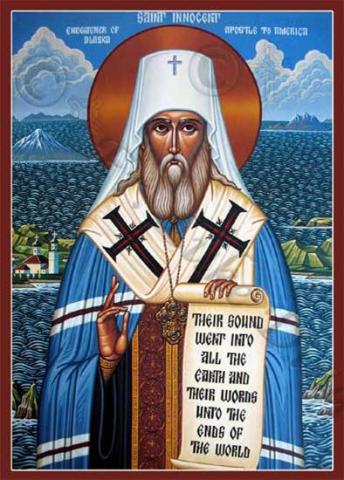Ages 6-8 Church History Overview/Schedules/Recipes
CHURCH SCHOOL CURRICULUM
CHURCH HISTORY
AGES 6-7
This sample schedule is provided for the convenience of Church School directors. Feel free to fill in your own dates and teachers!
Teachers:
Date Topic Teacher Special Notes
Sept. 8 Gala Opening Outdoor Movie Night Quo Vadis
Outdoors, with bonfire, entire parish
9 Pentecost/Philip & Eunuch
16 Stephen
23 Conversion of Saul
30 Peter and Cornelius
Oct. 7 Council of Jerusalem
14 Spread of Gospel
21 John/Revelation
27 Movie Night Ben Hur
28 Paul and Journeys 12:30 All Saint’s Party
Nov. 4 Paul and Journeys
11 Peter
18 Dormition
25 Persecutions
Dec. 1 St. Nicholas Festival Rehearsal of play after
2 St. Nicholas Play 12 Noon Congregation
1 PM Nursing Home
9 Constantine
16 Elevation of the Cross
23 St. Mary of Egypt
30 Canon of Scripture Memory: Books of Bible
Gospels and Acts ages 3-7
Theophany jars following
Jan. 6 Athanasius/Creed
Council of Nicea 12:30 PM Three Kings Party
13 Chrysostom/Liturgy Memory Work: Creed
20 Three Hierarchs Homeless Bags
27 Cyril of Alexandria/Councils
Feb. 3 St. Nina/St. Patrick/Councils
9 Movie night after vespers El Cid
10 Fall of Rome
17 Byzantine Empire/Justinian Memory: Trisagion Prayers (3-5 just thrice holy)
24 Rise of Islam
March 2 Icons/St. John of Damascus Art Day after Church School
6 Movie Night after vespers Becket/Man for All Seasons
9 Monasticism/ St. Anthony/St. Seraphim
16 Cyril and Methodius/
Baptism of Russia
23 St. Gregory Palamas Memory work: Jesus Prayer
30 The Crusades
April 6 Fall of Constantinople
13 Protestant Reformation
20 Protestant Reformation
- PASCHA – no Church School
- Easter Egg Hunt and Cookout
May 4 Armenia/Antioch
- Ethiopia/Alexandria
16-18 Camping Trip: No Class
25 Greece/Constantinople Memory: Lord Have Mercy” 5 languages (3-5 one)
June 1 Serbia, Romania, Bulgaria
8 Japan
15 Ukraine, Russia, OCA
21 Rehearsal after vespers Balailaka on the Onion Dome
Movie night Scarlet and Black
22 End of Year Play All Parish and Nursing Home
Awards Presentation
PLEASE READ CAREFULLY!
Stock Craft Supplies: available in your cabinet; let me know if you use the last of something, or replace it yourself before the next week.
Crayons Pencils Magic Markers
Popsicle sticks White glue Glue sticks
Construction paper White paper plates Scissors
Stapler Clear tape Pencil sharpener
Chenille sticks
References for this course:
Books are available for class use. While each child in the younger classes will have a copy of the Beginner’s Bible, and it’s always fun to start out in your very ow
n Bible book, many times we must supplement with the teacher’s copies of the Children’s Bible Reader, Read with Me Bible, Golden Children’s Bible, or other
books. Much of the rest of the year for the younger classes looks a bit like the “saint of the week”. This is OK. The small children can learn of the lives of the major players in the events like the church councils, while the older children study the doctrinal issues and decisions.
Paperwork and insurance regulations: Each of us must “apply” each year for our volunteer position; our references will be checked as per diocesan regulations. We will also have a parent volunteer who could come into any classroom at any time as required by the insurance company. Please be sure not to send small children to the bathroom unattended and accompany your charges back to the church building after class – again new safety regulations.
Lesson plan:
We will be dismissed first from liturgy for the children to get refreshments; while they eat, we will have opening exercises. In about 10 minutes, lessons will begin andshould last about 30 minutes. Begin with a prayer and introductions for any new students. Tell the story. Each lesson is followed by one or more craft ideas. Please feel free to use the suggested craft, or your own! Learning game suggestions are also included. Review the story. Recite memory work. End with prayer. If you are unable to teach on your assigned day, please trade with someone and then let me know (to avoid mid-Liturgy panic when I don’t see you in the congregation).
Each lesson is also accompanied by a full page-size coloring sheet of the subject of that lesson. This special sheet, also included in the take home for that week, printed on cardstock, will serve as a classroom timeline of sorts. Each week the children, together, can decorate the figure (color, glitter glue, yarn hair, cotton balls, wiggle eyes, whatever you have) and then hang it in the classroom. Easy way? Hang a string around the classroom and paperclip or clothespin the figures in order. A novel way to do a timeline for the very young and to provide easy reference and review material for the entire year.
Movie Nights and Parties: We will have supper after vespers on Saturday night while showing a small children’s movie. Older children should bring a sleeping bag for a lock-in with “feature” presentation; we must have at least 2 adults at each overnight.
Plays: Play rehearsal for St. Nicholas play and end-of-year play will occur during opening exercises and should not disrupt your lessons + after the St. Nicholas Festival. If you are assigned on the day of the play, that means you can help with costumes, etc.; we need all the help we can get!
Pat Disharoon (410-233-5337)
RECIPES
CLAYS PAINTS
SALT DOUGH FINGER PAINT (4 WAYS)
2 cups flour Use pudding with food coloring!
1 cup salt Mix liquid starch and food coloring.
about 1 cup water Mix 3 T sugar, ½ cup cornstarch, and
food coloring 2 cups cold water. Cook over
bath oil, vegetable oil, peppermint oil low heat, stirring, till thick.
Mix flour and salt. Add water Pour into muffin tin. Add
slowly and mix with your fingers until food coloring to each cup.
it makes dough. Knead in a few drops
food coloring and a splotch of oil (if SAND PAINT
desired). Store in air-tight container. Add dry tempera paint to corn meal.
Sprinkle over areas “painted” with thinned white glue
SELF-HARDENING CLAY
1 cup sand for a sand effect. Shake off excess.
½ cup cornstarch
1 tsp powdered alum PASTES
¾ cup hot water PRIMARY PASTE
Food coloring if desired Mix ½ cup water and 1 cup flour
Mix sand, cornstarch and alum in a bowl. Spoon into a jar
in large pot. Add hot water and stir or squeeze bottle to store.
vigorously. Add food coloring if
desired. Cook over medium heat PAPIER MACHE PASTE
until thick, stirring constantly. 3 cups water
After cooling, store in airtight container. 1 ½ cups flour
Mix flour with cold water until lumps are gone.
SAWDUST CLAY
2 cups fine sawdust Dip strips of newsprint in paste and mold around
1 cup flour surface to be shaped. Air dry.
Mix sawdust and flour in bowl
or bucket. Add a little water at a time, CORNSTARCH DOUGH
stirring till it is stiff but pliable. Knead 2 cups cornstarch
till it’s elastic and easy to shape. Store 4 cups baking soda
in airtight container. Air dry. 2 ½ cups water
Mix cornstarch and soda in large
pot. Add water. Cook, stirring, over medium
heat until thick like mashed potatoes. After
cool, knead on wax paper for 5 minutes.
Store in an airtight container. Air dry.
Pentecost/St. Philip and the Eunuch
PENTECOST/PHILIP AND THE EUNUCH
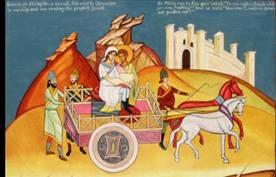 Objectives:
Objectives:
- Understand that Pentecost is the birthday of the Church.
- Know that the Holy Spirit descended at Pentecost
- Understand the importance of baptism and chrismation.
Possible Lesson Plan:
- Open with prayer.
- Read the stories in the Beginner’s Bible pp.472-487, the CBR pp 268-269 and the Read with Me Bible, pages 411-414, and/or the Golden Children’s Bible, pages 462-463. Review with the students the story of Theophany, the baptism of Jesus. Where was he baptized? By whom? Who spoke and what appeared? Use the icon as a storytelling aid, identifying the characters and their roles. Who’s the little person in the center? (He represents the whole world.) Think a bit about the whole world – all the different peoples and customs. If you have pictures or dolls of people from around the world, show them now. Do they all dress alike? Look alike? But God sent His Spirit to all of us.
Start your timeline with Pentecost and St. Philip with the Ethiopian.
- True/False Questions:
True False
The Holy Spirit came as tongues of The Holy Spirit came as a dove at
fire at Pentecost. Pentecost.
Chrismation is the sacrament of the Peter baptized the eunuch.
coming of the Holy Spirit
The eunuch was from Ethiopia. Theophany is the feast of Jesus’s birth.
Philip baptized the eunuch. The eunuch did not believe in Jesus.
- 4. Try just a bit on the Holy Spirit: Can we see the wind? Can we see what it does? Turn on a fan and watch their hair blow, pieces of paper move, etc. Can something invisible be very strong? When is the wind very strong? (tornado, hurricane, etc.) The Holy Spirit is like the wind. We cannot see it, but we can feel it. It is very strong. It is all around us and in us. So when the Holy Spirit came, the disciples could not see it, but they felt it and could hear it blowing and it changed their lives. The day when the Holy Spirit came down is called Pentecost; practice the word. When did each of us receive the Holy Spirit? (Chrismation)
We’ve now met all the Persons of the Trinity. This is a mystical concept, confusing to even adults. But let’s discuss it briefly. Practice making the sign of the cross and saying “in the name of the Father, of the Son, and of the Holy Spirit.” Who is the Father? Remind the children of the Lord’s Prayer; say it together. Who is the Son? (Jesus) Who is the Holy Spirit?
Simple craft? Take 3 craft sticks and glue together in a triangle. Write Father, Son, Holy Spirit on each one. One triangle, 3 sides. Trinity snack? How about 3-flavor Neopolitan ice cream? 1 sundae, 3 flavors.
- The Church was born on Pentecost. Even though Jesus had risen from the dead, the disciples were still frightened and didn’t know what to do. After the coming of the Holy Spirit, the disciples could speak many languages and they were no longer afraid. They went all over the world, telling people about Jesus. What did some of the disciples do after Pentecost? (wrote gospels, traveled to far lands, baptized people, died for Christ) Have a Birthday Party for the Church, complete with cake and candles. How old is the Church?
- A baptism is a very special time. Ask the children if they have seen a baptism? Who is present? What happens? Take them to see the font. Show pictures of a baptism. Ask if they were baptized? Who are their godparents? Explain that their godparents held them and held a candle and promised to help them grow to be strong and love God. Explain that they were undressed and dipped in the water three times, then dressed in white, new clothes. Their hands, feet, chest, forehead, eyes, ears, mouth, and throat were all blessed with holy oil; with small children let them touch each part. With older children, explore why these parts were chosen. They were given a cross; are they wearing a cross today?
- Role-play a baptism – Dress an immersible baby doll in a blanket. Have a baptismal outfit ready. With younger children, the teacher will have to be priest and tell the others what to say; older children can read the “script”:
Priest (making sign of cross in water in tub): May this water be sanctified with the power of the Holy Spirit.
All: Amen.
Priest (with hand on head of baby): In the name of the Father, and of the Son, and of the Holy Spirit, I lay my hand upon your servant (name) who has come to be a part of your family. Since this baby cannot speak for himself, who will answer for him?
Godparents (1 holding baby and 1 a candle): We will.
Priest: Do you hate Satan, the devil, and all of his evil ways?
Godparents: We do.
Priest: Turn and spit on him. (Godparents do this.) Do you want to be baptized?
Godparents: I do.
Priest: Do you believe in Jesus Christ?
All: Recite the creed. (Godparents now remove the blanket)
Priest (anointing baby using cotton swab dipped in oil making sign of cross):
The servant of God (name) is anointed with the Oil of Gladness in the name of the Father and of the Son and of the Holy Spirit.
All: Amen.
Priest (taking naked baby and immersing 3 times in a tub of water): The servant of God (name) is baptized in the Name of the Father, and of the Son, and of the Holy Spirit.
All: Amen.
Priest (after godparents dress baby in baptismal robe): The servant of God (name) is dressed in the Baptismal robe in the name of the Father, and of the Son, and of the Holy Spirit.
All: Amen.
- Sing “As many as have been baptized…” 3 times while the “baby” is marched 3 times around the room.
7. Make a Diorama:Take a shoebox. Glue light blue paper in the back and decorate with
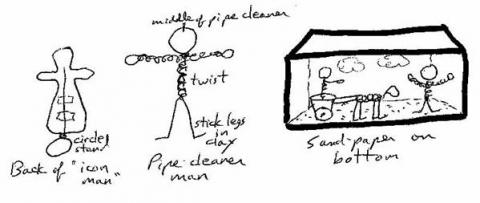 clouds, etc. Instead of grass on the bottom, since this is the desert, try sandpaper. Make chariot with a cup and wheels of cardboard with a pipe-cleaner axle and shafts. People can either be made from pictures cut from icons and taped to a pipe-cleaner stand or shaped completely from a pipe-cleaner (2 for a horse). Stick legs in clay to stand up. Arrange nicely in box. Can you tell the story from your diorama?
clouds, etc. Instead of grass on the bottom, since this is the desert, try sandpaper. Make chariot with a cup and wheels of cardboard with a pipe-cleaner axle and shafts. People can either be made from pictures cut from icons and taped to a pipe-cleaner stand or shaped completely from a pipe-cleaner (2 for a horse). Stick legs in clay to stand up. Arrange nicely in box. Can you tell the story from your diorama?
Too time-consuming? Easier yet…cut out the figures from the icon printed on cardstock, fold the bottom back and tape in place. No shoebox? Use a nice thick piece of sandpaper and add the figures
- Close with prayer: Lord, help me to share your love with someone each day, as Philip did with the eunuch.
St. Stephen
STEPHEN

Objectives:
- Know that Stephen was the first martyr.
- Know that a martyr is someone who dies for his belief in Jesus.
Possible Lesson Plan:
- Open with prayer.
- Read the story in the CBR pp. 269-271 or the Golden Children’s Bible, pages 466-467. Review here the definition of martyr and have each child say the word.
Add St. Stephen to your timeline.
- True/False Questions:
True False
Stephen was the first martyr. Peter was the first martyr.
Stephen died by stoning. Stephen was crucified like Jesus.
A martyr is someone who dies for Jesus. A martyr doesn’t believe in Jesus.
- Stephen was one of the first deacons. Peter and the other apostles chose seven men to help them in caring for the early Church. Say the word “deacon”. Talk about a deacon: He is a priest’s helper. He helps in the Divine Liturgy and helps the priest by visiting the sick, praying for people, etc. Do we have a deacon?
5. Make “Pet Rocks” to commemorate the stoning of Stephen: Go on a little hike around the churchyard. There are lots of rocks to select from. Be sure the children select paperweight size rocks – not tiny pebbles or boulders. Bring them back to class and wash and dry them. Paint with tempera paints and glue a piece of felt on the bottom. Write “Stephen, the first martyr” on the top of each rock with a magic marker.
6. Close with prayer: Lord help me to love you so much that, like Stephen, I would be
willing to die for you.
Conversion of Saul
CONVERSION OF SAUL
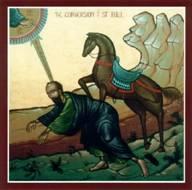
Objectives:
- Who was Saul?
- What was Saul doing at Stephen’s stoning?
- How did Saul meet Jesus?
Possible Lesson Plan:
- Open with prayer.
- Read the story in the Beginner’s Bible pp. 488-493, the CBR pp. 272-276 or Read with Me Bible, pages 415-421, and/or the Golden Children’s Bible, pages 467-469. Repeat the names “Saul” and “Ananias” with the children.
Add the conversion of Saul to your timeline.
- True/False Questions:
True False
Saul held the coats of the stoners of Stephen. Saul always loved Jesus.
Saul was struck blind. Saul was crucified.
Jesus spoke to Saul on the road to Damascus. Jesus spoke to Saul in Galilee.
Ananias healed the eyes of Saul. Peter healed Saul’s eyes.
- See what it’s like to be blind: In a pillowcase, put various objects of different textures and shapes. Blindfold the children and see how many they can identify. Fill various small bottles with smelly objects (banana, cinnamon, garlic, pickle, peanut butter, onion, etc.) See if the blindfolded children can identify the things by smell alone.
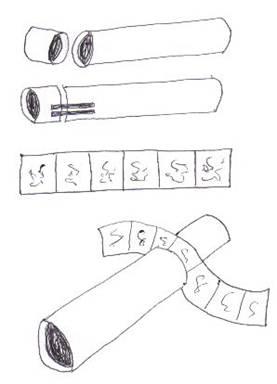
- Make a Picture Projector. Take a paper towel tube. Cut off about 1 inch at one end. Tape two Popsicle sticks side by side to hold the two pieces of tube together, leaving a ¼ inch slit between the tubes. Take a long, thin strip of paper divided comic-strip style into 4-5 sections. In each section, draw a scene from the story. Insert the paper “film” into the “projector”, hold it up to the light, and tell the story with your pictures. Not enough time to draw the story? Use the prepared "film".
- Close with prayer: Lord, may I keep my eyes open to all that You do in my life.
St. Peter and Cornelius
PETER AND CORNELIUS
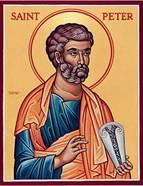 Objectives:
Objectives:
- Children should be able to tell the story of Peter and his vision.
- Children should know the meaning of the words “Jew” and “Gentile”.
- Children should know that Jesus loves all people.
Possible Lesson Plan:
- Open with prayer.
- Read the story in the Golden Children’s Bible, pages 470-471. Discuss the meaning of the word, “Jew”, and say it a few times. Remind the children about the story of Abraham (or reread it) and how God chose this people. For what purpose? To prepare for Jesus, the Messiah. The Jewish people called all other people “Gentiles” and did not associate with them. Can the children recall any instances when Jesus did talk to a non-Jew, or even perform a miracle? (the Samaritan woman at the well, the Roman centurion’s servant) . Remind them also (or reread) that God gave a strict law to Moses that included which animals were “clean” and which “unclean”. “Unclean” animals were not allowed to be eaten, just as we do not eat meat during Great Lent. Review the definition of clean: animals that have divided hooves and chew cud and sea creatures with fins and scales. Look at pictures of animals to see the hooves and fins and scales; bring pictures of animals (or a book from the library) to class as a reference for the next activity.
Add St. Peter to your timeline.
- True/False questions:
This time have the students choose from those below clean and unclean and look at pictures and discuss their eating habits to make your decision. You could use stickers and a sheet of construction paper divided into two columns; let the students put the correct side of the paper.
Clean Unclean
Cow Pig
Lamb Rabbit
Goat Dog
Salmon Shrimp
Bluefish Oyster
- Remind the children that Jesus loves all people, everywhere, and commands us to do the same. None of God’s children is “unclean”. Bring pictures of children of other lands with dress, skin color, customs different from ours. Sing “Jesus loves the Little Children” several times.
- 5. Make Peter’s dream on a sheet: Take a handkerchief or other piece of white fabric or a piece of a sheet. Glue to it stickers of “unclean” animals or even animal crackers. Tie a string to each corner so it can be raised and lowered as you retell the story. No sheet? How about a coffee filter, using pipe cleaners for the corners? Or even a paper plate…
6. Close with prayer: Lord help me to love everyone this week with Your love.
Council of Jerusalem
THE COUNCIL OF JERUSALEM
Objectives:
- Who was there?
- Where did the first council meet?
- What did they decide?
Possible Lesson Plan:
- Open with prayer.
- Read the story below:
Not long after Peter and Paul began to tell the Gentiles about Jesus, many
Gentiles became Christians. But, the Jewish Christians were upset. The Gentiles did not obey the laws of Moses; they had never known the Old Testament Scriptures. And they were not circumcised, as God had commanded Abraham for the Jewish people. Many of the Jewish Christians tried to tell the Gentiles that they had to become Jews first in order to be Christians.
Saul, now called Paul, and Peter went to Jerusalem, the holy city of the Jewish people. There they told the other James, the bishop of Jerusalem, and the apostles and elders of the church about their visions (Remember Peter’s? Remember Paul’s?) and about the love the Gentile believers had for Jesus. Peter told how God had sent the Holy Spirit to Cornelius and his family, just as He had to the Jewish believers. Finally James spoke: The Gentiles would not have to become Jews, but only not eat from meat sacrificed to idols. All the elders agreed that this was fair and right and James wrote a letter to all the churches about this important decision and sent it with Judas (a Jewish believer) and Silas (a Gentile).
Add St. James the Just to your timeline. He is pictured with a Liturgy since he wrote the very first liturgy used by the early church. The Liturgy of St. James is still served on his feast day.
- Enjoy Jewish culture a bit: Talk about Hanukkah – dreidls and potato latkes – and Passover. Remember the story of Moses and God’s people escaping from Egypt. Show a picture from a library book of a Jewish wedding with the canopy. Look at pictures of synagogues and Jewish people in prayer shawls. Many of these customs are like ours but many are not. Talk a little about our customs and holidays. It’s fun to learn about other people’s customs, but how would you like to be told you had to dress and eat and celebrate exactly like your Jewish friends?

- The earliest non-Jewish believers were mostly Greeks. Take a look at the Greek alphabet. If you take the first letters of the words, “Jesus Christ, Son of God, Savior,” in Greek and put them together, you get the Greek word for “fish”. For this reason, early Christians often identified themselves to each other with a simple drawing of a fish. Have the children practice drawing fish on paper or in a sandbox.
5. Make Peanut People Finger Puppets: Break peanuts in half for each puppet. For this story, try Peter, Paul, James, Silas, and Judas. Draw on faces and add cloth or paper head coverings, yarn hair and beards, etc. Practice telling the story with the finger puppets. Someone allergic to peanuts? No problem! Just take small strips of paper or cardstock, roll into cylinders, and decorate in the same way for finger puppets.
6. Close with prayer: Lord, help us to make decisions fairly and wisely every day.
Spread of the Gospel
SPREAD OF THE GOSPEL
Objectives:
- Students should be able to name the early apostles.
- Students should know where at least some of them traveled.
Students should be able to tell what “evangelism” means.
Possible Lesson Plan:
- Open with prayer.
- Tell the story of the apostles as given on the next two pages, have a globe handy to show the destinations of these travelers:
LIVES OF THE APOSTLES (IN BRIEF)
Where did they all go, these men who followed Jesus so closely? Let’s look quickly at their lives after the Ascension and Pentecost.
St. Andrew, the first-called, a fisherman by trade and brother of Peter, traveled to Scythia, Greece, Byzantium (later known as Constantinople), and finally to Russia. He is the patron saint of Russia and finally died on an X-shaped cross, preaching the whole time he was on the cross until his death.
St. Thomas, better known as “Doubting Thomas” because of his doubts about the Resurrection, surely had no doubts after he saw Jesus with his own eyes. He traveled to far-off India to spread the good news of his faith and there, he died.
St. Bartholomew was born in Cana of Galilee and first was sent by the apostles to Syria and Asia Minor. In the city of Hieropolis, there lived a man called Stakhios. Stakhios had been blind for 40 years, but was healed through the prayers of the apostle and was baptized. Soon many were being healed and leaving the pagan gods for Christ. This angered the pagan priests, who had St. Bartholomew, along with St. Philip arrested. Bartholomew survived crucifixion there, left Stakhios as bishop, and also is believed to have traveled to India and began the Christian Church there, translating the gospel of Matthew from the Hebrew for the new believers. He then traveled to Armenia, where he preached for many years and healed the daughter of King Polimios through prayer. King Polimios, his wife and daughter, and many people from the ten cities of Great Armenia became Christians. Finally, at the urging of the pagan priests, a wicked king named Astyages in the nearby city of Al’ban ordered Bartholomew killed.
St. Simon (the Zealot) left Palestine and traveled first to Egypt to preach about Jesus. St. Jude left Jerusalem after Pentecost and traveled to the land of Mesopotamia. In and around the city of Edessa he preached the good news of Jesus and the resurrection. Finally, he went to Persia with St. Simon and there, in Persia, both of these courageous apostles died for their faith.
St. James the Greater, son of Zebedee and brother of St. John the Beloved, traveled to Spain to preach; he is the patron saint of Spain to this day and is known there as Santiago (Our own San Diego is named for him.). He returned to Jerusalem to try to influence the Pharisees to accept Christ. But, the Jews still hated the Christians and begged King Herod Agrippa to put James to death. James was the first of the apostles to die and the second martyr (after Stephen).
St. Philip introduced many members of the Greek community to Christianity. After performing many miracles in Jerusalem, including giving sight to the blind and restoring life to a dead infant, he traveled with is sister, Mariamne, to Phrygia in Asia Minor. There he preached to the people of Hierapolis. These people worshipped a huge snake; Philip prayed and the snake died. Many people who had been bitten by snakes were healed, including the wife of the governor. Many of the people then believed in Jesus, but some were so angry they put Philip in prison. When Philip would not deny Jesus, he was crucified, head down, along with the Apostle Bartholomew. A great earthquake struck, and Philip prayed for the safety of those present. The earthquake stopped, and Philip and Bartholomew were taken down from the cross. Bartholomew was still alive and established a bishop for the newly-converted people of the city, but Philip, through whose prayers the city had been saved, had already gone home to be with his Lord.
St. Matthew remained for many years in the land of Israel, teaching the Jewish people about Jesus. He wrote the gospel of Matthew to tell the story of Jesus to his people. Finally, he traveled to Ethiopia to preach and was killed by those who hated Christians in that African land.
St. James the son of Alpheus, also known as James the Less and brother of St. Matthew, traveled after Pentecost first to the city of Eleutheropolis and then to Egypt. There he preached and performed miracles with great success and churches were founded. Finally he was killed in the town of Ostracina, being crucified by pagans.
St. Matthias was chosen by casting lots to take the place of Judas Iscariot, who betrayed Jesus. He had been on of the 70 men sent out by Jesus to preach and perform miracles. He was with the other 11 disciples at Pentecost and preached in the land of Judea. Then he traveled to the land of Cappadocia and began the church there. He also died for his faith.
There are 2 other very special apostles, even though they were not part of the first 12 chosen by Jesus.  St. Barnabas was actually named Joseph; the apostles changed his name to Barnabas, which means “Son of Encouragement”. St. Barnabas was born on the island of Cyprus, and was a fellow-student of Saul (later to be St. Paul) in Jerusalem under the teacher, Gamaliel. He became a follower of Jesus and was one of the chosen Seventy. We see glimpses of his work in the book of Acts. He was one of those who sold all he had in the early church in Jerusalem. Next we see him leading the newly converted Saul back to Jerusalem to meet the other Christians there. He was sent by the church in Jerusalem to Antioch, where believers were first called Christians. After a year in Antioch with Paul, the two set out on their first missionary journey. They took with them on that journey a cousin of St. Barnabas, John Mark. John Mark, later the Evangelist Mark, left the two apostles part-way through the journey. Barnabas also traveled with Paul to Jerusalem for the first church council. But, when Paul refused to trust John Mark to come on his next journey, Barnabas took Mark to Cyprus. Barnabas then traveled to Rome, perhaps the first to preach there about Jesus. He traveled to Mediolanum (now Milan) in Italy and then returned to Cyprus. There, St. Barnabas and St. Mark preached together for many years until Barnabas was stoned to death in Salamis in about the year 62 at age 76.
St. Barnabas was actually named Joseph; the apostles changed his name to Barnabas, which means “Son of Encouragement”. St. Barnabas was born on the island of Cyprus, and was a fellow-student of Saul (later to be St. Paul) in Jerusalem under the teacher, Gamaliel. He became a follower of Jesus and was one of the chosen Seventy. We see glimpses of his work in the book of Acts. He was one of those who sold all he had in the early church in Jerusalem. Next we see him leading the newly converted Saul back to Jerusalem to meet the other Christians there. He was sent by the church in Jerusalem to Antioch, where believers were first called Christians. After a year in Antioch with Paul, the two set out on their first missionary journey. They took with them on that journey a cousin of St. Barnabas, John Mark. John Mark, later the Evangelist Mark, left the two apostles part-way through the journey. Barnabas also traveled with Paul to Jerusalem for the first church council. But, when Paul refused to trust John Mark to come on his next journey, Barnabas took Mark to Cyprus. Barnabas then traveled to Rome, perhaps the first to preach there about Jesus. He traveled to Mediolanum (now Milan) in Italy and then returned to Cyprus. There, St. Barnabas and St. Mark preached together for many years until Barnabas was stoned to death in Salamis in about the year 62 at age 76.
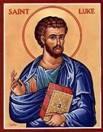 Finally, St. Luke, the Evangelist, was also an early companion of Paul. He was a Roman citizen and physician from the city of Antioch. He traveled with Paul through Asia Minor on Paul’s second missionary journey. He wrote down all they did and all he learned about the life of Jesus; we can still read these today in the Acts of the Apostles and the Gospel of Luke. He painted an icon of the Virgin Mary, which he gave to the Theotokos herself; this is still a prized possession of the Patriarchate of Constantinople. Luke lived to be an old man and died in Thebes at the age of 84.
Finally, St. Luke, the Evangelist, was also an early companion of Paul. He was a Roman citizen and physician from the city of Antioch. He traveled with Paul through Asia Minor on Paul’s second missionary journey. He wrote down all they did and all he learned about the life of Jesus; we can still read these today in the Acts of the Apostles and the Gospel of Luke. He painted an icon of the Virgin Mary, which he gave to the Theotokos herself; this is still a prized possession of the Patriarchate of Constantinople. Luke lived to be an old man and died in Thebes at the age of 84.
Add St. Luke to your timeline.
- True/False Questions:
True False
St. Luke was a doctor. St. Luke was a lawyer.
St. Thomas went to India. St. Philip had three sons.
St. James is the patron of Spain. St. Matthias was one of the original 12.
St. Andrew took the gospel to Russia. Barnabas means “Ugly Son”.
- Have each student concentrate on one saint: Make an Illustrated Biography book with each student drawing a picture of the life of one of the apostles. Put the name of the apostle at the top of each page. Have the student tell the others about “his” apostle. Then punch holes along the side and mount with a piece of ribbon or yarn as a class book.
- One could write a little ditty, having the students pick out one fact they think is important about each character and singing to the tune of the 12 Days of Christmas – for example:
The first of the apostles was Andrew; he is the patron saint of Russia.
The next of the apostles was Doubting Thomas, India was his goal and Andrew
Patron saint of Russia.
The next of the apostles was Simon Zealotes, traveled to Egypt; Thomas went to
India, and Andrew patron saint of Russia. Etc., etc.
- Say the word “evangelism” several times. What does it mean? Are we evangelists?
- Close with prayer: Lord, make me as brave as the apostles in telling everyone
about You.
St. John and the Revelation
JOHN/REVELATION
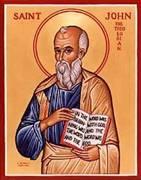
Objectives:
- Students should be able to identify the apostle John.
- Students should be able to identify the Book of the Revelation as John’s writing.
- Students should be able to identify the Second Coming.
Suggested Lesson Plan:
- Open with prayer.
- Read the Beginner’s Bible 504-508 or the CBR 292-295. The Golden Children’s Bible has a short section on John on pages 509-510 and the Read with Me Bible on pages 436-437. Supplement with the following story; have ready the icons of the Transfiguration, Crucifixion, Ascension, and Pentecost to identify John in each (and break up the story):
A very, very old man sat alone in the hot sun. It was Sunday and the man was praying. Suddenly the silence of the deserted island was split by a loud voice like the sound of a trumpet, telling the old man, “Write in a book what you see, and send it to the seven churches.” The man turned to see who was speaking to him and saw the Lord Jesus in all His glory, risen and surrounded by angels. Jesus gave the man messages for the churches. Then He showed the man the glory of the heavenly kingdom, with the heavenly creatures and angels and risen Christians worshipping the Lord forever and ever. The man saw a vision of the end of all the earth and the victory of the Lord over all His enemies, a mighty and fearful vision. The man wrote down all he had seen, just as the Lord had commanded.
Who was this old man? His name was John, one of the twelve apostles who had known Jesus and traveled with Him in the land of Galilee. John had been a young man when Jesus had called him and his brother James while they were mending their fishing nets. The two brothers, sons of Zebedee, had followed Jesus and listened to His teachings and watched His many miracles. John had seen the Lord Jesus revealed in power at the Transfiguration. He had seen the raising of Jairus’s daughter and later of Lazarus from the dead. He had helped Peter prepare the Last Supper. He had been with the Lord as Jesus prayed in the Garden of Gethsemane. He had seen the Lord taken by the soldiers and condemned to die on the cross. John had been the onlyu one of the disciples to stand at the foot of the cross with Jesus’s mother Mary and the other faithful women. Jesus had looked down from the cross and told John to care for His mother, and John took Mary into his own home from that day. When Mary Magdalene ran to the frightened and hiding disciples to tell them the Lord was risen, John and Peter had run to the tomb to see for themselves. After the Resurrection, John had seen and talked with Jesus many times until Jesus ascended into heaven. All of these things – the life and death and Resurrection of Jesus that John had seen and heard with his own eyes and ears – he wrote down for all of us in the book we now call the “Gospel of John”.
After the Resurrection, John was one of the leaders of the early Church. He helped Peter and James in guiding the church in Jerusalem. Then, John traveled to Asia Minor and settled in the city of Ephesus. From Ephesus he led the church in Asia. John was known for the loving concern he had for his brothers and sisters. A story is told that, while traveling in a certain city, John saw a young man and entrusted him to the bishop of the city to teach him about the Lord. But, when John came back to the city, he was told that the young man had made bad friends and had become a robber. This made John very sad, and he went into the mountains where the robbers lived. He was captured by the robbers and found the young man and told him that Jesus still loved him. The young man then cried and said that he was sorry for his evil way of life and went back to the church. So, the apostle John cared for his churches with love and charity.
When John was already an old man, loved by Christians everywhere, he was the only one of the twelve still alive. When the Emperor Domitian, a cruel and wicked ruler, came to the throne, he ordered John captured by the soldiers and brought to the Emperor in Rome. There, he tried to kill John in a pot of boiling oil, but John was not hurt at all. (Remember the story of the three men in the fiery furnace?) Since he could not kill the apostle, the emperor sent him to the deserted island of Patmos. There John had the great vision of the Lord and wrote the book we now call “The Revelation” in the Bible.
Finally, Domitian died and John was able to go back to Ephesus. From there he wrote three letters, which we now have in our Bible as the “Epistles of St. John”. As an old man, John told the people over and over to love each other. John died peacefully in Ephesus and joined the Lord he had loved so well.
Add St. John to your timeline. Perhaps the archangel Michael as well?
- True/False Questions:
True False
John was a fisherman. John was a carpenter.
John took Mary into his home. John was too scared to come to the cross.
John had a vision on the island of Patmos. John was killed by boiling in oil.
John died peacefully as an old man. John was known for his hatred.
- The Book of the Revelation is much to complex and the subject of too much theological controversy to approach with this age group. But – all children have dreams. Let them discuss their dreams. What is the difference between a dream and a vision? There are many instances of dreams and visions in the Old Testament that we already have studied – the dreams of Pharaoh, the dreams of the butler and the baker, the vision of Samuel, the visions of the prophets (e.g. Ezekiel and the bones). And in the gospels, Joseph had two life-changing dreams – when God told him to marry the Theotokos and when the angel told him to escape from Bethlehem to Egypt. Review these stories – look at the pictures in their Read with Me Bibles. God can speak to us in both visions and dreams. John’s vision was full of angels and trumpets – an end-time parade.
- What is an angel? Ask to children to describe as they understand angels. Angels are God’s attendants and messengers. The Orthodox Church teaches that there are 9 “choirs” of angels: angels, archangels, powers, authorities, principalities, dominions, thrones, cherubim and seraphim. Do the students remember any of these mentioned in our liturgy? Angels are invisible (most of the time; can you think of an exception? The Annunciation!), of tremendous power and strength. They don’t have bodies as we know them. Try to fill these blanks with either “people” or “angels” or “angels and people”:
_______________ were created by God. _________are always young.
_______________have bodies. _________think and do things.
_______________never die. _________need to eat and drink.
_______________have names.
- Make an paper plate angel head: Take a large paper plate before class, cut out the center and spray paint gold (or use gold glitter in class). Take a small plate and draw face and add hair of yarn or fabric or felt. Cut wings from a 12x18 sheet of construction paper in white. Glue or staple face in front of halo and wings behind.
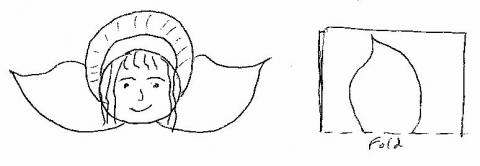
- Close with prayer: Lord, let me see You this week all around me in my dreams and in your invisible helpers, the angels.
St. Paul and His Journeys, Part 1
PAUL AND HIS JOURNEYS
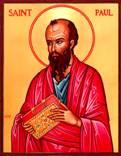
Objectives:
- Students should know that Saul and Paul are the same person.
- Students should learn the general plan of Paul’s travels, all around the Mediterranean.
- Students should know that Paul traveled first with Barnabas and John Mark.
Possible Lesson Plan:
- Open with prayer.
- First review the story of Saul’s conversion. Read the 1st part of the story of Paul in the Beginner’s Bible 494-499, the CBR 275-277 or Read with Me Bible, pages 422-423, or the Golden Children’s Bible pages 473-477. While the distances and continents involved are beyond the comprehension of this class, ask the children about trips they have taken. How did they prepare? Where did they go? How did they travel? Who went with them? Why did they go? Compare and contrast with Paul’s journeys.
Add St. Paul and St. Barnabas to your timeline.
- True/False Questions:
True False
Saul and Paul are the same person. Peter and Paul are the same person.
Paul escaped from Antioch in a basket. Paul escaped Antioch in a balloon.
Paul went on his first trip with Barnabas. Paul went on his first trip with Judas.
John Mark went with Paul and Barnabas. John Mark stayed for the whole trip.
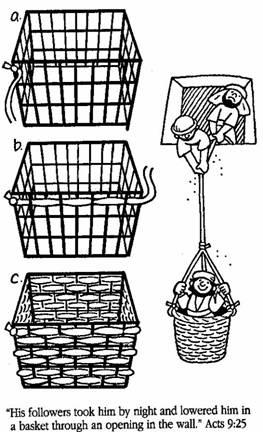 Do you suppose Paul and Barnabas were “best friends”? They met in Antioch. Barnabas helped Paul escape and took him to Jerusalem. They went back to Antioch as a team to lead the church there. Then the church sent them off on a missionary trip together. They came back together, but without John Mark, and when they were ready to set out on the next trip, Barnabas wanted to take Mark and Paul did not feel Mark could be trusted. The two men split up over this argument! How do you suppose they felt? Have any of the children had a best friend move away? Or just quit playing with them? How do you feel if your best friend goes away without you? Paul and Barnabas, even though they were saints, were not perfect and quarreled, but later they forgave each other!
Do you suppose Paul and Barnabas were “best friends”? They met in Antioch. Barnabas helped Paul escape and took him to Jerusalem. They went back to Antioch as a team to lead the church there. Then the church sent them off on a missionary trip together. They came back together, but without John Mark, and when they were ready to set out on the next trip, Barnabas wanted to take Mark and Paul did not feel Mark could be trusted. The two men split up over this argument! How do you suppose they felt? Have any of the children had a best friend move away? Or just quit playing with them? How do you feel if your best friend goes away without you? Paul and Barnabas, even though they were saints, were not perfect and quarreled, but later they forgave each other!
- Make Paul’s Basket: Take a berry basket or similar of plastic. Tie a one-yard length of yarn to the top corner. Weave in and out of holes around the basket, working your way down, tying on another length of yarn as needed. Add 4 pieces tied to the top as a hanger; this can be used for hanging small plants.
- Close with prayer: Lord help me to trust you to take care of me in everything I do.
St. Paul and his Journeys, Part 2
PAUL AND HIS JOURNEYS, PART 2
Objectives:
- Students should know the general plan of Paul’s travels all around the Mediterranean.
- Students should know that Paul traveled later with Silas.
3. Students should know that Paul traveled last to Rome as a prisoner and died there.
Possible Lesson Plan:
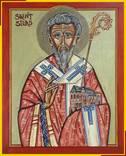 Open with prayer.
Open with prayer.- Read the story of Paul’s later travels in the Beginner’s Bible pp. 500-503, the CBR pp. 278-291 or Read with Me Bible, pages 424-435, and/or the Golden Children’s Bible, pages 477-507. This is a lot of story to read: My favorites are Paul and Silas in jail in Philippi and the shipwreck on the way to Rome. Review the name “Silas” as Paul’s traveling companion on his later trips. Do the children remember anyone else from earlier lessons who traveled with Paul? (Luke, the physician, Barnabas and John Mark). Who wrote down the story of Paul’s travels? (Luke) In what book of the Bible is this recorded? (Acts)
Add St. Silas and St. Timothy to your timeline.
- True/False Questions:
True False
Paul traveled with Silas later in his life. Paul took Silas on his first trip.
Paul and Silas were in jail in an earthquake. The earthquake killed Paul and Silas.
Paul’s ship was wrecked on the way to Rome. Paul’s ship was wrecked in Antioch.
Paul died in Rome. Paul died in Jerusalem.
- Discuss “natural disasters”: What is an earthquake? Has any of the students felt one? What happens? What could have happened to Paul and Silas? What were Paul and Silas doing when the earthquake hit? What really happened? What was the end result? What is a storm? Have students describe a storm: thunder, lightning, wind, darkness. Has anyone been in a boat in a storm? What happens to the waves? What can happen to the boat? What was Paul doing in the boat? What really happened? What was the end result? So, God can use natural “disasters” for His own purposes. Do we need to fear earthquakes, storms? Try singing the song from the Sound of Music, “My Favorite Things” with these words:
Earthquakes in jail cells that break open chains.
Storms in the ocean that lead ships to land.
Soon people hear of the word of the Lord,
These are a few of my favorite stories:
When the snake bites, when the rocks sting, when I’m feeling sad.
I simply remember my favorite stories and then I don’t feel so bad.
- Paul went to Rome as a prisoner. He was beheaded there. So, Paul, too, was a martyr; review the word. Why was Paul in jail? Was he guilty of a crime? What crime? Is it illegal today to be a Christian? In our country? In other countries?
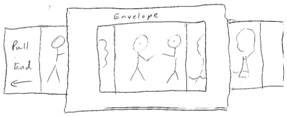 6. Make an Envelope Viewer: Cut a TV-screen hole in the front of a business-size envelope. Lick the envelope shut and cut off both ends. Color the movie strips on the next pages, or have students draw their own. Insert the strip in the viewer and pull through to see the story. Can the students tell the story with their “movie”?
6. Make an Envelope Viewer: Cut a TV-screen hole in the front of a business-size envelope. Lick the envelope shut and cut off both ends. Color the movie strips on the next pages, or have students draw their own. Insert the strip in the viewer and pull through to see the story. Can the students tell the story with their “movie”?
- Close with prayer: Lord, help me to be brave and trust you through all the scary things in life.
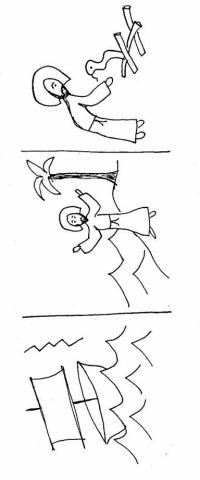
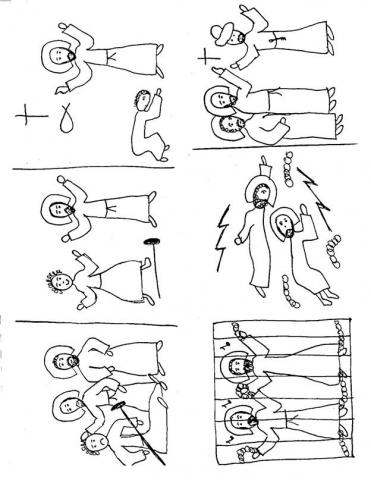
St. Peter
PETER
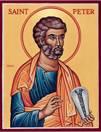 Objectives:
Objectives:
- Students should know that Peter was one of Jesus’s twelve disciples.
- Students should know that Peter started the church in Rome.
3. Students should know that Peter died as a martyr, upside down on a cross in Rome.
Possible Lesson Plan:
- Open with prayer.
- First, review the story of the calling of Peter at his fishing boat; pick him out in the icons of the Transfiguration, Ascension, and Pentecost. Who spoke to the crowds at Pentecost? Next review the story of Peter and Cornelius; who was the first to take the gospel to the Gentiles? Peter was also at the Council in Jerusalem. Now continue his story with the Read with Me Bible, pages, and/or the Golden Children’s Bible, pages 472-473 and 464-466.
St. Peter and St. Paul are already on your timeline but why not add the very famous icon of the two foremost apostles together?
- True/False Questions:
Peter was a fisherman. Peter was a doctor.
Peter saw a vision of animals on a sheet. Peter saw a vision of a fiery furnace.
Peter went to Rome to tell people about Jesus. Peter lived in Israel all his life.
Peter died upside down on a cross. Peter was stoned to death.
- Peter was also one of the Lord’s greatest apostles. Work a bit on the words “disciple” and “apostle”. Say the words and have the students repeat them. Peter was both – the disciples were the original followers of Jesus who studied and lived with the Lord during His life on earth. So, a disciple is a student, a follower. How many of the original twelve can the students name? One man was chosen to take the place of the one who betrayed Jesus? Who betrayed Jesus? Who took his place? How was Matthias chosen? “Apostle” is someone sent out by the Lord to establish His Church. So, an apostle is a leader, a teacher. Peter was a disciple who, on Pentecost became an apostle. What happened on Pentecost? Paul never knew Jesus on earth but was sent by Him to establish churches all over the Mediterranean world. See if the students can land these famous people in the right category:
Disciple Disciple and Apostle Apostle Neither
Judas Iscariot Peter Paul Abraham
Thomas Silas David
Andrew Luke Daniel
John
James
Are there still apostles in modern times? Watch future lessons for the answer.
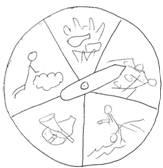 Make a Spin-a-Story Wheel of the life of Peter: Begin with a paper plate. Divide into about 6 sections. In each section, draw a scene from the life of Peter: fisherman (or fish or fish sticker), Transfiguration (part of icon cut from old bulletin file?), denial of Jesus (rooster or rooster sticker), Pentecost (flames), Peter and Cornelius (pig?), and death upside down on a cross in Rome (upside down cross). Cut a spinner out of tagboard (or another plate). Attach with a piece of pipe cleaner bent; a round bead between spinner and plate helps it spin better. Can the students spin and tell each of the stories of this amazing apostle?
Make a Spin-a-Story Wheel of the life of Peter: Begin with a paper plate. Divide into about 6 sections. In each section, draw a scene from the life of Peter: fisherman (or fish or fish sticker), Transfiguration (part of icon cut from old bulletin file?), denial of Jesus (rooster or rooster sticker), Pentecost (flames), Peter and Cornelius (pig?), and death upside down on a cross in Rome (upside down cross). Cut a spinner out of tagboard (or another plate). Attach with a piece of pipe cleaner bent; a round bead between spinner and plate helps it spin better. Can the students spin and tell each of the stories of this amazing apostle?
6. End with prayer: Lord, make me now Your good disciple learner.
Dormition
DORMITION
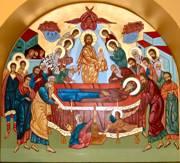 Objectives:
Objectives:
- Who was at this major event?
- What happened?
- When did it happen?
- Where did it happen?
Possible Lesson Plan:
- Open with prayer.
- Read the story, using the icons of the Nativity, Crucifixion, and Dormition:
Mary was the Mother of Jesus, the Theotokos. God was His Father. When Jesus was a baby, Mary cared for Him and fed Him and gave Him His bath. But, all that time, she knew that this baby was different from other babies: He was the Son of God. Mary spent thirty years doing all the things a mother and wife must do. She cooked and cleaned and scrubbed and sewed. Her bare feet were dusty from the hard work of her little home in Nazareth.
Later, when Jesus was grown, He left home to begin His life’s work. Mary saw little of her Son during the years of His teaching and miracles. But, she still loved Him as mother loves her child.
Mary was at the foot of the cross when her Son, Jesus, was dying there. Jesus saw her and knew how sad His pain and suffering made His mother. He called out to His disciple, John. John was to care for Mary as if she were his own mother. And so, for the rest of her life, he cared for the Theotokos as a loving son.
After the day of Pentecost, Mary stayed in the city of Jerusalem, living with the disciple John. She comforted and worked lovingly with the new Christian church.
When Mary was about 50 years old, she was sick and dying. She told her friends that she wanted to be buried in Gethsemane, the garden where Jesus prayed. At that time, all of the apostles were scattered around the world preaching the Gospel. When they heard of Mary’s dying, they all returned to Jerusalem. Some made the journey by foot; others were miraculously transported by the Lord Himself. All arrived in time except St. Thomas, also known as Doubting Thomas. The apostles are pictured on either side of Mary, St. Peter at the head of the bier and St. Paul at the foot of the bier. With everyone gathered, Mary “fell asleep” in Christ. She died peacefully, knowing that the resurrection of her Son would also be hers.
Below the bier in the icon we see Antoninus the Jew. He was an enemy of the Christian community and tried to break up the burial of Mary by dumping over the bier. An archangel appeared and cut off the hands of Antoninus to keep him from dishonoring the Theotokos. Antoninus was very sorry for what he had done and knew now that Jesus really was the Son of God. His hands were healed and he became a Christian.
When Thomas arrived, the other disciples took Thomas to the tomb in Gethsemane where Mary had been buried near her parents, Joachim and Anna. But the tomb was empty! The Church believes that Mary was resurrected bodily and taken to heaven, just as we all will be in the future.
Add Mary, the Theotokos, to your timeline.
- True/false Questions:
True False
Dormition means “falling asleep”. Below the bier in the icon we see Jesus.
Sts. Peter and Paul are in the icon. Thomas arrived on time to see Mary.
The apostles returned for Mary’s death. Mary died in Rome.
Mary died in Jerusalem. Antoninus was Mary’s friend.
Thomas found Mary’s empty tomb. Mary lived to be 100 years old.
- Discuss the association of flowers with this feast. According to tradition, when the apostles went to visit the tomb of Mary, instead of finding her body, they found only the burial cloths and the tomb was filled with the fragrance of flowers. We bring flowers to church to be blessed and place them at the icon of the Theotokos. We can then take home the flowers to give her fragrance to our homes.
- Make a Popsicle theater. Background could be a gift box or a 12x18 piece of construction paper folded in half to stand up or a shoebox or shoebox lid. Decorate background with flowers. Then cut out the icon pieces on the next page. Color and tape a Popsicle stick behind each figure. Tell the story with your puppets.
- Close with prayer: Lord, help me this week to feel the closeness that Mary felt with You and the love she had for You.
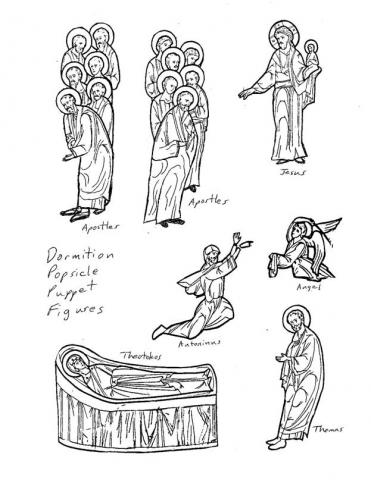
Persecutions: St. Barbara
PERSECUTIONS

Objectives:
- Students should be able to say the word “persecution” and know its meaning.
- Students should be able to name Barbara and tell her story.
Possible Lesson Plan:
- Open with prayer.
- Read the story of St. Barbara as follows:
In the early days of the Church, it was dangerous to be a Christian. Many of the Emperors of Rome did not like Christians because they would not worship the gods of Rome and the Emperor himself. Do you remember the stories of the three young men in the fire and Daniel in the lion’s den? (Review them here; there are pictures in the children’s Bible storybooks.) Just like these men who loved God, early Christians were burned and eaten by lions. The Romans killed Christians just for believing in Jesus. People who are killed for what they believe are called martyrs. St. Barbara was a martyr. Here is her story.
King Dioscuros loved his daughter Barbara; she was his only child and his special joy. He wanted to keep her safe forever and built in the courtyard of his palace a tall tower. At the very top of the tower lived Barbara. There she was safe from sickness, dangers, and enemies. King Dioscuros worshipped the pagan gods of Rome and hated the new beliefs about a man named Jesus that were sweeping across the land. He was certain that, at the top of a tower ,Barbara would never hear of Jesus. Her loving father kept Barbara almost a prisoner; she could only see the countryside from the windows of her tower. She had teachers who told her of the world outside. She would look out her window and see the beauty of the world – the sky and the stars and the sun and the birds. Surely a God created this beautiful world.
To keep her from getting too lonely, King Dioscuros would allow young girls from noble families to visit Barbara in her tower. Barbara, with her curious and lively mind, asked her friends about the world. From them she heard of Jesus Christ. He was the Son of God, the Creator of the beautiful world Barbara saw from her windows. Barbara decided secretly to become a Christian, too. Her father had built her a bathhouse with a beautiful pool. While her father was away, Barbara decided to make a third window for her pool for the Holy Trinity and had a cross cut in stone above the pool. Then she was baptized in her pool.
When her father returned, he saw the changes in the bathhouse. Barbara excitedly told him she had made the changes and had been baptized. King Dioscuros was furious! He drew his sword to kill his daughter! Barbara ran down the stairs of the tower and escaped to the mountaintop nearby. There she prayed to God for help.
The next day the soldiers of the king found Barbara. King Dioscuros locked her in a tiny room and came to her every day asking her to give up her belief in Jesus. But, Barbara would not deny Jesus. Finally, her father sent her to the palace of the governor. There she was given a simple choice: worship the gods of Rome or be killed. Barbara told the governor that she would rather die. She was beaten by the soldiers and thrown into jail with another Christian woman named Julia. There a bright light appeared to Barbara and told her not to be afraid; when she woke up, all of her bruises were gone. The governor beat Barbara again, and again she was healed. Finally, he ordered King Dioscuros to kill his own daughter. Dioscuros hated Christians so much, that he was willing to do even this and beheaded Barbara and Julia on the very mountaintop where she had been captured.
Add St. Barbara to your timeline.
- True/False Questions:
True False
Barbara’s father was King Dioscuros. Barbara’s father was King Paul.
Barbara lived in a tower. Barbara lived in a cave.
Barbara was baptized in her own pool. Barbara was baptized in the River Jordan.
Barbara was beheaded by her father. Barbara died of her beatings.
- Barbara is listed by the Church as a saint. What are her “saintly” attributes? What about her life? In what ways was her life saintly? What about her death? Had he done anything wrong to be killed as a martyr? Discuss the word “persecution” and review “martyr”. Say them a few times. What do they mean? Are Christians persecuted anywhere today?
- Make St. Barbara’s Tower: Take a paper towel tube. Add a cone at top for a roof. Decorate with windows, etc. Add a pipe-cleaner figure of Barbara looking out of the top window. Or, take the picture of St. Barbara, color it, and tape into the window.
- Close with Prayer: Lord, help me to love You as much as did Barbara.
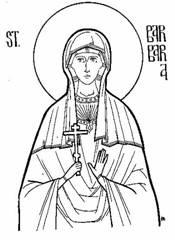

St. Constantine
SAINT CONSTANTINE
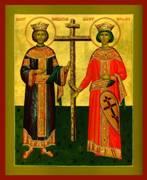
Objectives:
- Students should identify Constantine as Emperor of Rome.
- Students should know “In Hoc Signo Vinces” and what it means.
- Students should know that with the Edict of Milan, Constantine made Christianity legal in the empire, ending persecutions.
Possible Lesson Plan:
- Open with prayer.
- Tell the story of Constantine as follows:
As the cruel Roman Emperor, Diocletian, grew old, he decided that when he died the Empire would be divided into four parts. The northern parts, France and England, were given to Constantius Chlorus. Constantius was a wise and just man; his wife, Helen, was a Christian. They had one son, Constantine. But, Constantius was saddened by the cruelty of the other kings, especially against Christians. He took his army against the wicked King Maxentius. In this battle, Constantius was killed and his son, Constantine, became king.
Constantine was not yet a Christian; he worshipped the gods of Rome. Constantine was at war with the wicked Maxentius. As he was crossing the Moldavian bridge, he saw in the sky a flaming cross. Written beneath this cross were the words in Latin, “In Hoc Signo Vinces,” which means, in English, “In this sign you shall conquer.” He knew that the cross was the sign of the Christians. He decided to give the Christian God a try. He had his soldiers carry a Christian cross into battle and they won! Constantine had defeated Maxentius! He now know that Jesus was the true God. When another of the kings, Galerius, died journeying to Rome, Constantine became ruler of the entire Western Roman Empire. The Arch of Constantine was built in Rome to commemorate his victory. His brother-in-law, Licinius, was ruler of the Eastern Empire. The first act of the two brothers was to issue a new law, the Edict of Milan, which said that Christians and all people could worship freely and build churches. But, soon, Licinius broke their agreement and began to kill Christians again. Constantine took his army and defeated Licinius in battle. Now Constantine was Emperor of the entire Roman Empire.
Constantine never forgot Who made him ruler of the Empire. He built many churches, including the first church of St. Peter in Rome. As a king, Constantine was known for his strong and wise leadership. He built a great army and navy. But, he was never fond of the city of Rome. He moved the capital of the Empire to the city of Byzantium and renamed the city Constantinople. Constantine established the Christian Church with such strength in the Byzantine Empire that the Christian Byzantine Empire stood for hundreds of years after the fall of Rome and the Western Empire. Finally, Constantine died and left his great empire to his three sons. History books have given Constantine the title of “the Great” and the Church also remembers him and his mother Helen as great, saints “equal to the apostles.”
Add Constantine the Great to your timeline.
- True/False Questions:
True False
Helen was Constantine’s mother. Mary was Constantine’s mother.
Constantine saw a cross in the sky. Constantine saw a rainbow in the sky.
The words in the sky were “In this The words in the sky were “In Rome
sign, you shall conquer.” you shall die”
The Edict of Milan gave Christians The Arch of Constantine gave Christians
freedom to worship. freedom to worship.
- Discuss for a bit the Roman Empire. Show pictures from a library or history book if possible. How did the people dress? How did they live? What gods did they worship? What kind of houses did they build? Monuments? Can the students name some other emperors? How much of the world did they rule? What is left today of Rome? Be sure the students can say “in hoc signo vinces” and “Edict of Milan”. Even today, in churches, we see “I””H””S” on various articles.
- Make Constantine’s
 crown: Use gold tinsel pipe cleaners and purple and white pony beads (glow-in-the-dark beads are even “cooler”). Twist the ends of two pipe cleaners together to make one long one (back and front of crown). On one pipe cleaner string the beads 1P, 5W, 1P, 5W to the end of the pipe cleaner with 1P. Stick a new pipe cleaner through the first purple bead in row one and twist with the other pipe cleaners neatly. String beads 4W, 1P, 4W, then go thru the next purple bead on the first row, repeating all the way down to the end. You’ll have to add another pipe cleaner about half way down to finish. Twist to the other pipe cleaners after going through the last purple bead. Fit to the head of the student by twisting back pipe cleaner to front on other side.
crown: Use gold tinsel pipe cleaners and purple and white pony beads (glow-in-the-dark beads are even “cooler”). Twist the ends of two pipe cleaners together to make one long one (back and front of crown). On one pipe cleaner string the beads 1P, 5W, 1P, 5W to the end of the pipe cleaner with 1P. Stick a new pipe cleaner through the first purple bead in row one and twist with the other pipe cleaners neatly. String beads 4W, 1P, 4W, then go thru the next purple bead on the first row, repeating all the way down to the end. You’ll have to add another pipe cleaner about half way down to finish. Twist to the other pipe cleaners after going through the last purple bead. Fit to the head of the student by twisting back pipe cleaner to front on other side.
- Close with prayer: Lord, let me take my cross up every day to defeat all my enemies in your name.
Elevation of the Cross
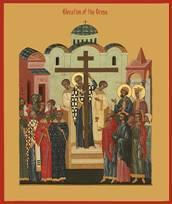 ELEVATION OF THE CROSS
ELEVATION OF THE CROSS
Objectives:
- Children should recognize a cross and how to make the sign of the cross.
- Children should know the story of St. Helen and the finding of the Holy Cross.
- Why is the cross important to us as Christians? Christ died on the cross.
The cross shows us how much Jesus loves us.
Possible lesson plan:
- Open with prayer. Practice making the sign of the cross as you pray.
- Tell the story of St. Helen and the finding of the Holy Cross, using the icon as a picture to illustrate the story for the students:
The Empress Helen, mother of the great Emperor Constantine, was traveling to the Holy Land, the land where Jesus had lived and died and risen from the dead. All the palace was in an uproar. The servants prepared food for the journey, packed the clothing, and made everything ready for the royal family to travel. The Empress was a Christian – one who believed that Jesus was the true God. She was going to the Holy Land to find the places and things the Bible told about.
Soon, the royal party – the empress, her ladies, her soldiers, and her servants – reached the Holy Land. The royal ship, with its sails of purple silk trimmed with gold, landed at the port of Joppa on the Mediterranean Sea. There, camels and horses and donkeys waited to carry them inland. The road was hot and dusty; the sun beat down on them. Finally, they reached the city of Jerusalem. They could almost feel the presence of Jesus. These were the very streets He had walked about 300 years before.
Empress Helen had the servants put up silken tents on a hill outside the city. The hill was called Golgotha, a dusty mound with a few bent and twisted old olive trees growing nearby. What was special about this hill? The Bible says that Golgotha was where Jesus was crucified. No one had seen the cross on which the Lord died, but, somewhere on that dusty hill, Empress Helen was sure that she would find three crosses. The Lord had given her many dreams and visions that had started her on this journey. He would surely show her how to complete her task. Helen Prayed. Then, she told her men to begin digging, not on top of the hill, but in a little gully to the side. As they dug, the men became more and more excited. Suddenly, one of them found something wooden. It was a cross! Soon, there were three wooden crosses uncovered. But, which one was the cross of Jesus Himself?
The Bishop of Jerusalem, Macarius, suggested a way to find out. He know of a woman who was sick, so sick she was about to die. He had his servants carry the woman out to the hill. The woman was tired and wondered what was happening. Then, the bishop asked the sick woman to touch the first cross; nothing happened. She touched the second cross; nothing happened. Then she touched the third cross; suddenly she was full of energy and life and was well again. Surely this was the true cross of Christ!
The Empress Helen sent word to her son, the Emperor Constantine, that they had found the true cross of Jesus Christ. There was rejoicing in all the Christian Churches. The emperor ordered that a church be built there on the Mount of Olives. He reminded all the people that, wonderful though it was to find the wooden cross on which Jesus was crucified, we do not worship the cross but the Lord who died on it. And so it is to this day.
Add St. Helen to your timeline.
- True/false Questions:
True False
Helen was the mother of Constantine. Constantine found the cross of Jesus.
Helen traveled to Jerusalem. Helen found the cross in Constantinople.
The cross was on a hill called Golgotha. The cross was in the Garden of Gethsemane.
A church was built where the cross was The bishop threw dice to choose the true
found. Cross.
Constantine was the Emperor of Rome. The Bishop of Jerusalem was Constantine.
- Talk about how a cross can look. Show examples of different styles of cross. Think about places where we see a cross, or take a “field trip” to the sanctuary to “hunt” for crosses.
5. Teach and sing, complete with prostrations:
Before thy cross, we bow down in worship, O Master,
And thy holy resurrection we glorify.
6. Cross Seed Mosaic: Take a paper plate. Draw a cross on it. Have available various seeds:
Lentils, dried peas, barley, black beans, dried corn, etc. to make different colors. Students can decorate the plate and cross with the seeds, outlining and making it beautiful.
- Conclude with prayer, again practicing the sign of the cross.

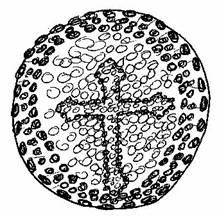
St. Mary of Egypt
ST. MARY OF EGYPT
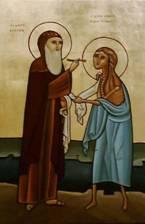 Objectives:
Objectives:
- Students should know who Mary was.
- Students should know the word “repentance”.
- Students should be able to tell the story of her life.
Possible Lesson Plan:
- Open with prayer.
- Tell the story of Mary of Egypt:
Mary was born in Alexandria in the land of Egypt. She was a very beautiful and very rich girl. She didn’t believe in God and said that she could do anything she wanted.
One day, Mary sailed to Jerusalem with her friends looking for fun. Now, it happened to be the time of the feast of the Ascension, and many Christians were going into the Church built over the tomb of Jesus to pray. Mary was curious. What were they doing? She tried to enter the church, but an invisible force pushed her back. She tried again and again, with no luck. She wondered why she could not enter the church. Could it be her sins that were pushing her back?
Suddenly, Mary began to change. She looked at an icon of the Virgin Mary and was ashamed of the way she had been living. She knelt before the icon and cried her heart out. God’s voice came to her and told her to go into the desert beyond the Jordan. At first, life in the desert was hard, remembering all the fun she used to have with her friends and her fine clothes and good food. In the desert, she was hungry and thirsty and had only rags to wear. But the Lord sent her wisdom and peace in her soul.
After fifty years, Mary saw a man walking in the desert. It was a monk, Zossima, who had come to pray. Mary asked Zossima to return the next year on Holy Thursday to give her communion for the first time since her repentance. Then Mary disappeared into the desert.
The next year, Zossima returned as he had promised. He waited on the banks of the river, which was flooded. How would Mary get across? The he saw her on the other shore. Mary prayed and walked across the water! Zossima gave her the beloved communion and Mary prayed the prayer of St. Simeon, “Lord, now lettest thou thy servant depart in peace…” Can you sing this great hymn? Do it now. Mary asked Zossima to return the next year.
The next year Zossima came and found Mary’s body; she was dead. She had written in the sand that she wished to be buried her, in the desert, where she had found the Lord in her heart. Zossima sang the memorial service for Mary, but he was an old man and could not dig the grave. Suddenly a lion came and dug the grave with his claws. Thus, Zossima and the lion buried Mary’s body while her soul went to be with her Lord in heaven.
Add St. Mary of Egypt to your timeline.
- True/False Questions:
True False
Mary was from Alexandria in Egypt. Mary was from Jerusalem.
Mary traveled to Jerusalem. Mary traveled to America.
Father Zossima found Mary in the desert. Zossima found Mary at McDonalds.
Zossima brought Mary communion. Zossima brought Mary a pickle.
A lion helped Zossima bury Mary. An elephant helped Zossima bury
Mary.
- Discuss repentance: Say the word over and repeat it. We use it a lot in church, but what does it mean? To repent is different from just feeling sorry for what we’ve done. It means to turn around and go the other way. Mary felt sorry in Jerusalem. But, her life in the desert was truly a complete turn-around from her former life. Have the students name some things Mary would have had and done in Alexandria; what about in the desert? Be sure the desert list is not all negative – she had peace and the love of God, etc. Now as the students if they have ever done something wrong? Can they tell about it? In what way have they repented? What would be a good way to show their repentance. For example, if they disobeyed their parents and didn’t clean their room, could they go and clean it extra good now and each time from now on? If they fought with their sister or brother, could they do something especially nice for them and give them a hug?
- Make Mary and Zossima bag puppets: Use the pattern for the puppet halves. Glue top of puppet to bottom of small paper bag and mouth part to part below so you can make the bags “talk”. Color the faces. Give Zossima white cotton ball hair and beard. Give Mary long, stringy gray yarn hair. Cut a circle of yellow construction paper and glue behind Mary’s head. Now, can the students, using their own words, reconstruct the scene between Mary and Zossima at their meeting?
Too time-consuming? Use the head of each from the icon, cut at mouth line, and paste to the bag to make your bag puppets.
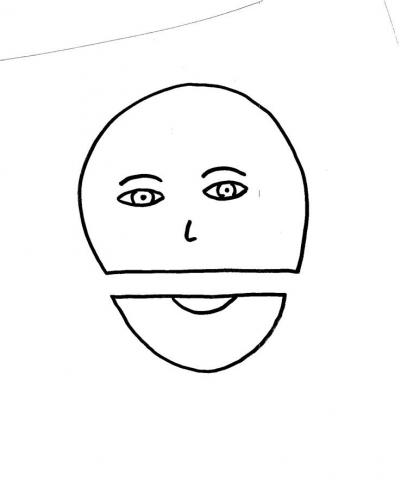
- Close with prayer: Lord, give me true repentance every time I do something wrong.
Canon of Scripture
CANON OF SCRIPTURE
Objectives:
- Students should know how we got our Bible.
- Students should know the word “Canon” and what it means.
- Students should memorize the names of the 4 gospels plus the book of Acts.
Possible Lesson Plan:
- Open with prayer.
- How did we get the Bible? In the early Church, the only Scriptures known were the
Old Testament or Hebrew Scriptures. It was written originally in their language, Hebrew, and then translated into Greek. The Greek version is called the Septuagint. Can you say that word? Septuagint. It was written long before Jesus was born. The Hebrew Scriptures tell about the creation of the world, God’s chosen people, God’s promises of a Savior, and the history of the Jewish people. Do you remember some of the stories from the Old Testament? Some of the books we memorized 2 years ago? Jesus Himself read from these Scriptures when He taught. This was the only Bible read by the apostles!
In the first days after Pentecost, the apostles taught the people about Jesus. The people memorized the stories and loved hearing them. So, even while the apostles were still alive, collections of stories about Jesus began to be written down. Peter probably supervised the writing of the gospel of Mark. Luke traveled and talked to many people to learn all about Jesus to write his gospel. And, of course, Matthew and John were with Jesus from the start and wrote what they had personally seen and heard. These books are called the gospels and tell about Jesus. They are the first four books of the New Testament.
Luke also traveled with Paul and wrote a book about the history of the early Church. This is called the book of Acts. The apostles traveled to many cities, starting churches all over the world. When you travel, don’t you send letters or postcards to those you miss at home or in other towns? So, the apostles wrote letters, or epistles, to others of their churches while they were elsewhere. Most were written in Greek. Paul, Peter, John, James, and Jude all wrote letters. In fact, they wrote a lot more letters than are in the New Testament. Some letters may have been fake or lies. But, from earliest times, certain ones of their letters went from church to church, copy by copy, by foot or donkey or horse or camel. Each copy was made by hand – each hand-carried with love to the next town to share with fellow believers. Even the apostles, in their letters, talked about the letters of the other apostles they had read! These letters were especially precious in the days of persecution, when they had to be hidden carefully from the Romans. In fact, during the reign of Diocletian, the Romans sent spies all over the empire and tried to destroy all Christian writings!
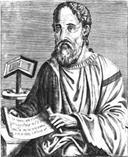 But, by the second century, many of these letters were well-known through the church. Early Christian bishops, Clement and Polycarp and Ignatius (Do you remember the story of Polycarp?), refer to them as being read in the churches. Origen, a great scholar and teacher, had by the year 200 made a list of writings that he considered to be really the work of the apostles. Finally, Constantine became Emperor and Christians were free to read the Scriptures in their churches openly. But, which Scriptures? Constantine gave the great historian Eusebius, who had lived through the persecution of Diocletian, a great order – to produce 50 Bibles. Eusebius carefully studied all the letters and gospels he could find and came up with a list of 27 books for the New Testament, the same 27 books we recognize today. Can you count to 27? The first are the gospels (Can you name them?), then the Acts, then lots of epistles (or letters), and finally the Revelation of John (Remember what it was about?).
But, by the second century, many of these letters were well-known through the church. Early Christian bishops, Clement and Polycarp and Ignatius (Do you remember the story of Polycarp?), refer to them as being read in the churches. Origen, a great scholar and teacher, had by the year 200 made a list of writings that he considered to be really the work of the apostles. Finally, Constantine became Emperor and Christians were free to read the Scriptures in their churches openly. But, which Scriptures? Constantine gave the great historian Eusebius, who had lived through the persecution of Diocletian, a great order – to produce 50 Bibles. Eusebius carefully studied all the letters and gospels he could find and came up with a list of 27 books for the New Testament, the same 27 books we recognize today. Can you count to 27? The first are the gospels (Can you name them?), then the Acts, then lots of epistles (or letters), and finally the Revelation of John (Remember what it was about?).
Add Eusebius of Caesarea to your timeline.
- True/False Questions:
True False
The Old Testament was written in Hebrew. The New Testament was written in
Hebrew.
The Gospels tell of the life of Jesus The Acts tell of the life of Jesus.
Epistles are letters. Epistles are made of chewing gum.
There are 27 books in the New Testament. There are 100 books in the New
Testament.
The Revelation is the last book of the Bible. Genesis is the last book of the Bible.
- Work on the books of the Bible – even the smallest children should be able to say the names of the gospels and know what a gospel is. Memory work for this week is the books of the Bible for the older classes; the 6-7 year-old children need only know “Matthew, Mark, Luke, John, Acts” to get their prize. Look thru their Bible storybooks, showing the Old Testament, the gospels, the Acts. Let them see a “real” Bible and look through it as well. Repeat the word “canon” a few times; this is the list of books that the Church, throughout holy tradition, has accepted as the word of God.
- Make a “Bible” for the class: The Bible is often divided into sections: The Torah, the History, Poetry, Prophets in the Old Testament and the Gospels, History (book of Acts) and Epistles (or letters) in the New Testament. Give each student a piece of Construction paper. Draw books on a bookshelf for each section and have students label the books. They can draw pictures of any scenes they remember from the stories of that section of the Bible. Put the whole bookcase display up on the bulletin board and review frequently for the next few weeks.
- Close with prayer: Lord, may I read your Holy Bible every day of my life.
St. Athanasius and the Creed
ST. ATHANASIUS AND THE CREED
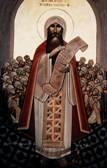
Objectives:
- Students should know the story of St. Athanasius and be able to say his name.
- Students should be able to say the first line of the creed.
Possible Lesson Plan:
- Open with prayer.
- Tell the story of St. Athanasius:
Athanasius was born at the end of the third century (How long ago was that?) in the city of Alexandria in Egypt. At that time, Alexandria was an important center of education and learning in the Roman Empire and its bishop an important leader in the Christian Church. One day, the bishop looked out his window and saw some small boys walking back and forth at the seashore. When he asked what they were doing, they said that they have made their friend, Athanasius, their bishop and are following his order to baptize the other children. Athanasius had taught the children all about Jesus and they were ready to follow the Lord! The bishop came to love Athanasius and the boy spent many hours in the bishop’s home reading and studying.
By the time he was 20 years old, Athanasius was writing books about the Lord. He believed that Jesus was truly God as well as truly man. But, another priest in Alexandria, named Arius, believed just the opposite. He believed that Jesus was a “superman” but not really God. He began to tell people that Jesus was a great hero. Even the Emperor Constantine heard of this great disagreement in the Christian Church and was upset by the arguments. So Constantine decided to hold a council of all the bishops. This council was held at Nicea in Asia Minor in 325 AD. Constantine himself was the presiding judge. Athanasius, still a young deacon, spoke to the bishops about the dangers of this new belief that Arius was spreading. Arius also spoke. The Council decided against Arius and wrote a creed, or statement of belief, that says, “Jesus Christ…being of one essence with the Father” to end the disagreement.
Athanasius soon became Bishop of Alexandria. But Arius was still alive and even the Emperor allowed Arius to keep teaching. Then he spread rumors that Athanasius had murdered a man. Athanasius went to Constantinople as a prisoner, but he showed them alive the man he was supposed to have killed! Even so, Athanasius was sent into exile – a prisoner in France for many years. When he finally came home to Alexandria, he again became Bishop. But, when a new Emperor arose who believed with Arius, Athanasius had to escape to Rome. He would try over and over to go back to Alexandria, only to have to flee – finally to the desert. But he never stopped writing about his beloved Jesus. Finally, as an old man, he was able to go home to Alexandria as its beloved bishop.
Add St. Athanasius to your timeline. If the timing in the year is good, also add St. Nicholas who also attended the council and is remembered for slapping Arius on the face.
- True/False Questions:
True False
Athanasius was from Alexandria. Athanasius was from Rome.
Athanasius believed that Jesus was God. Athanasius believed Jesus was superman.
Arius believed that Jesus was a hero. Arius believed that Jesus was God.
- Athanasius is called “The Great” by the Church. Why? He defended Jesus against false beliefs for many years. Think a bit about how important it is for Christians to know that Jesus is God. Have the students talk about superman (or spider man, batman, etc.) What are they like? What powers do they have? Are they God? What is different about God? Yes, Jesus was powerful and could walk on water, but His birth, death, and resurrection mean nothing if He was just another superhero!
- Role-play the council: Have one child be Constantine with a gavel. On one side Athanasius and on the other Arius. The rest of the class are bishops. Put on robes from our costume closet if you want. Constantine should pound his gavel. Arius shouts “Jesus is superman!” and Athanasius answers, “Jesus is God and man!” Repeat till the whole class knows the cries of each man.
- Practice the sign of the cross. The three fingers stand for God the Father, the Son, and the Holy Spirit. And the two fingers down on the palm stand for the 2 natures of Jesus – God and man – who came down to earth. Have the students practice. Do they know what the fingers stand for?
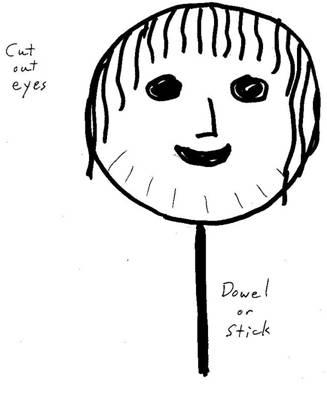
- Work on the creed. The memory work for the next few weeks is the Creed. Sing it together a few times. When do we sing it in liturgy?
- Make masks for your role-play above: Use paper plates. Cut eye-holes and draw faces. Constantine will need a construction paper crown and beard, Athanasius and Arius beards, others with bishop’s hats (Remember that Athanasius was only a deacon at the time of the Council and Arius a priest.). Punch a hole on each side and tie a piece of yarn thru each. Tie in back to secure to the student’s heads for your “performance”. Alternatively, attach a long stick to the back and students can hold the masks in front of their faces. Do you want to perform for next week’s opening exercises? Let me know.
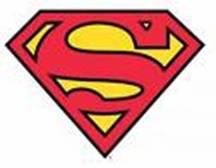 Alternate Craft: Superman plate – Take a large paper plate. On one side, glue the Superman logo with a large X thru it and write “Arius” underneath. On the other, glue an icon print of either St. Athanasius or of our Lord, maybe from old church bulletins. Turn back and forth, reminding the children of the main issue of the Council of Nicea and its major players.
Alternate Craft: Superman plate – Take a large paper plate. On one side, glue the Superman logo with a large X thru it and write “Arius” underneath. On the other, glue an icon print of either St. Athanasius or of our Lord, maybe from old church bulletins. Turn back and forth, reminding the children of the main issue of the Council of Nicea and its major players.
10. Does the lesson happen to fall right around Nativity? Why not make a Creed ornament? Print on cardstock and cut out, fold tabs, and tape or glue together. The Creed is the church's statement, and our own with "I believe" of Who the Father is, Who the Son is, Who the Holy Spirit is, and who the Theotokos is.
11. Close with prayer: Lord, help me to be strong in what I know is true, even when everyone else disagrees with me.
St. John Chrysostom and the Liturgy
ST. JOHN CHRYSOSTOM AND THE DIVINE LITURGY
Objectives:
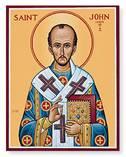 Students should be able to say the name, St. John Chrysostom, and tell his story.
Students should be able to say the name, St. John Chrysostom, and tell his story.- Students should know that he wrote the Divine Liturgy we celebrate most Sundays.
Possible Lesson Plan:
- Open with prayer.
- Tell the story of St. John Chrysostom:
St. John Chrysostom was born about 300 years after the time of Christ in the city of Antioch in the land of Syria. His parents, Secounthos and Anthousa, were very rich. They became Christians before John was born, and John was baptized when he was very young. Secounthos died when John was a boy, and Anthousa taught him carefully about Christ Jesus and the Christian life.
When he became a young man, John went to Athens to study in the university there. In Athens, he soon became known for his wonderful preaching. He became famous all through the land. In face, his name “Chrysostom” is not his last name at all but means “Golden-Tongued” and was given to him because of his wonderful speaking. One day, John was telling men who believed in other gods about the Lord Jesus. One of these men, Anthemios, fell down to the ground shaking after denying the true God. John prayed for Anthemios and he was healed. Anthemios and many others of the learned men then became Christians and were baptized.
When John finished his schooling, he returned to Antioch and became a monk. During this time, many people who were sick came to him for prayer and were healed. Some farmers even came to him because they were afraid of a lion which killed many people. John told them to pray to God and gave them a wooden cross to place on the road. The next morning, the lion was found dead in front of the cross. St. John lived in the monastery for four years, performing many miracles and serving as an example of Christian life. He then left the monastery to live alone in the desert a life of prayer. But, John became ill and had to go back to Antioch. He was ordained a deacon and served the Patriarch, St. Meletios, for five years.
When Patriarch Meletios died, the new patriarch, Flavianos, saw a vision telling him to take John to Constantinople and there ordain him a priest. The next day, they left Antioch for Constantinople. As the patriarch was ordaining John, a white dove appeared and sat on John’s head, showing the blessing of the Holy Spirit. (What other time did the Holy Spirit appear as a dove?) John went back to Antioch as a priest. Soon, the Patriarch of Constantinople died and John was named patriarch. He had to be sneaked away from Antioch in a carriage because the people loved him so much they did not want him to go. During John’s time as Patriarch of Constantinople, John continued to preach the Word of God with great wisdom. He also wrote many books of sermons and interpretations, composed hymns, and gave us the Divine Liturgy still celebrated today.
But, John was never afraid to speak out against those who did not live the way of Christ. Because of this, he made many enemies, including the emperor’s wife, whom he criticized for her greedy and selfish way of life. Finally, she brought a list of lies against John to the bishops and had John sent away. The people tried to stop this, and hundreds of Christians were killed by the empress’s army. John spent his last four years as a simple priest in the village of Cacussus.
Add St. John Chrysostom to your timeline.
- True/False Questions:
True False
“Chrysostom” means “Golden tongued”. John’s last name was Chrysostom.
The lion was killed in front of cross. The lion died in front of a mouse.
A dove sat on John’s head. A crow sat on John’s head.
John was Patriarch of Constantinople. John was Patriarch of Jerusalem.
- St. John Chrysostom (Have the children repeat his name.) wrote the Divine Liturgy as we celebrate it most Sunday’s of the year. Have the children repeat until they can say correctly “divine liturgy”. Explain that this is the special service that we have to worship God. Review the parts of the liturgy; children should be able to chime in with answers as they recognize the things they have heard and sung for years:
- Litany: Here we pray for the whole world. Who else do we pray for? (travelers, prisoners, leaders of our country, bishops, priests, deacons, rain and sun, food to eat, and we especially remember Mary the Theotokos) What do we respond? (Lord have mercy. Grant it, O Lord.)
- Hymns of worship: 1st and 2nd antiphons, troparia and kontakia, Trisagion -- review these words. Try singing the antiphons we use each Sunday.
- Epistle and Gospel: Here we hear God’s word from the Bible. God speaks to us from His special book, the Gospel Book, which is kept on the altar table. The priest carries out the Gospel and tells us to pay attention to God’s word.
- Cherubic Hymn: God makes us His special guests, along with the seraphim and cherubim, His angels in heaven. The priest uses incense as he prays, reminding us that the prayers go up to God the same way the smoke rises. The discos holds the holy bread and the chalice the communion wine. The tabernacle on the altar holds communion for those who are sick and cannot come to church. The priest carries the chalice and discos in the Great Entrance, while praying for us all!
- Creed: We all recite the creed –review the writing of the creed by the Fathers of the Church in Nicaea under Constantine the Great.
- Preparation for Communion: Review the story of the Last Supper. Here the priest prays for the bread and wine to become the true body and blood of Jesus. We say “Amen” and bow to the altar.
- The Megalynarion: We honor Mary the Theotokos with a special hymn.
- The Lord’s Prayer: Can we say it together? Jesus gave us this prayer himself.
- Holy Communion: Review crossing the arms, opening the mouth, kissing the chalice. Have the children practice this.
- Benediction: The priest blesses us and dismisses us. We all kiss the Cross.
- Make a Liturgy Book for each child. They can use these in Liturgy to help them remember the parts of the service. Take 4 pieces of paper and fold in half. Staple all together in the middle. On the front write “My Liturgy Book”. On the first page, print “Litany” and draw some of the things we pray for in the litany – an airplane or car or train or boat, fruit or vegetables, sun, prison bars, red cross for hospital, Orthodox cross for the church. On the next page, print “Hymns” and try some musical notes. Next print “Holy Bible” and draw a picture of the Bible, then “Cherubic Hymn” with an angel to represent the cherubim (Do you remember the various “ch
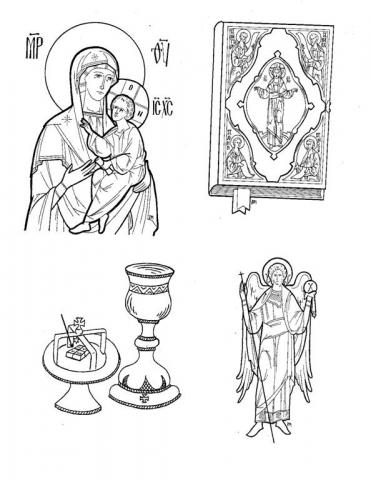 oirs” of angels from the lesson on Revelation?). Then print “Creed” with a picture of Constantine, or just a crown. “Preparation for Communion” with bread and a chalice follow, then “Megalynarion” with a small picture of Mary (We have lots of these in our old bulletin covers file.). “The Lord’s Prayer” with praying hands would be next, then “Holy Communion” with the chalice and bread again, and finally “Benediction” and a cross to kiss. If drawing these themselves takes too long, use stickers for some. Here are also some pictures that will help.
oirs” of angels from the lesson on Revelation?). Then print “Creed” with a picture of Constantine, or just a crown. “Preparation for Communion” with bread and a chalice follow, then “Megalynarion” with a small picture of Mary (We have lots of these in our old bulletin covers file.). “The Lord’s Prayer” with praying hands would be next, then “Holy Communion” with the chalice and bread again, and finally “Benediction” and a cross to kiss. If drawing these themselves takes too long, use stickers for some. Here are also some pictures that will help.
Too complex? Use the pages below and just fill in and color:
- Close with prayer: Lord, help me to use my tongue to speak only what you want me to say.
Three Hierarchs: St. Gregory Nazianzus
THE THREE HIERARCHS
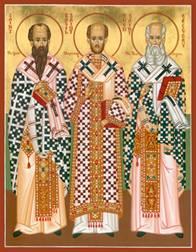
Objectives:
- For these students, concentrate on St. Gregory Nazianzus – his life and how he served the Lord.
- Students should know the word “hierarch” and that it means bishop.
- Students should be able to name the three hierarchs: Basil the Great, Gregory Nazianzus the Theologian, and St. John Chrysostom..
Possible Lesson Plan:
- Open with prayer.
- Tell the story of St. Gregory:
Gregory was born in the small town of Nazianzus in Asia Minor. His mother taught him about Jesus. But Gregory wondered, why did he never see Jesus? Was Jesus real?
Gregory was a very good student. He first studied in the little school in Nazianzus. Then he went to Alexandria, and finally, when Gregory was 16 years old, he decided to go to Athens. His parents were very sad; he would be so far away. Gregory boarded the ship and set sail. But, soon a storm came. It was so fierce that the captain lost control of the ship. For days they were lost in the darkness and rain. They had no food or water. Gregory prayed and prayed. Finally the storm ended and another ship came, giving them food and supplies. They were saved! Gregory knew that his prayers had been answered and he knew that Jesus was really God.
In Athens, Gregory met his old friend Basil from the school in Alexandria. They were both studying in Athens. Soon the two friends were living together and spent 10 years studying in Athens. Finally, Gregory got a letter from home. His father, now the Bishop of Nazianzus, was old and needed help with his work. Gregory left Athens and his friend Basil and went home. His family were so happy to see him! Gregory helped his father to manage their farm and home, but he became ill. He left Nazianzus to join Basil at a monastery in the mountains and there got well again.
But, all was not well at home. Gregory traveled to Nazianzus for a visit. As he approached his house, he saw a crowd of unbelievers with clubs and logs! They were going to batter down the door and kill his family! Gregory was a small, shy, bald man, but he ran right in front of the crowd and stopped them at the door. He spoke to them for an hour, telling them about Jesus and God, until the whole mob became Christian! After this, the people of Nazianzus loved Gregory and his family. They asked for Gregory to be their priest. Gregory fled back to Basil and the monastery, but Basil sent him back; God had called Gregory to be priest and he must obey.
Several years later, when Basil was Bishop of Caesarea, he ordained Gregory Bishop of Sasima. Gregory was angry; he did not want to go to Sasima. He refused to obey. The next year was a terrible one – first his beloved brother Caesarius died, then his sister, his father and mother, all the animals of the land and even the crops with a hailstorm – even his good friend Basil died. All his family and friends were gone; Gregory cried and cried. He went out alone to the mountains, lost in his loneliness. But, Gregory came back from the mountains a new man, strong in the Lord. He was now not afraid to teach the people. He wrote books and letters about the Lord. Many of his writings we have to this day. Because of his wise writings, Gregory of Nazianzus is also known as Gregory the Theologian.
Add the three hierarchs to your timeline.
- True/False Questions:
True False
Gregory and Basil were good friends. Gregory and Basil were brothers.
Gregory was from Nazianzus. Gregory was from Athens.
Gregory saved his family from an angry Gregory ran away from the mob and
mob. hid.
- Think a bit about fighting evil: Who do you picture when you say someone is a great fighter for good and against evil? Maybe Superman or Batman? What characteristics does a fighter of evil need to have? Strength? Boxing or karate skills? Tall? Now picture St. Gregory Nazianzus. Short, small, shy, and bald…Review the story of David and Goliath; it’s in the Read with Me Bible. What characteristics does God
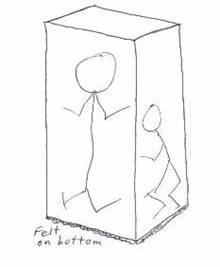 look for in a fighter of evil? Does God look for the same things we do? Can I be a fighter of evil?
look for in a fighter of evil? Does God look for the same things we do? Can I be a fighter of evil?
- Make Bible Bookends: Take a brick for each child. Spray paint it (your choice of color) or leave it bare; glue a piece of felt on one small end. Color the pictures of each of the “Three Hierarchs” – St. Basil, St. Gregory Nazianzus, and St. John Chrysostom. Do they remember St. John Chrysostom from last week’s lesson? Repeat the three names until the students can say them and identify them as the Three Hierarchs. Cut out and glue one on each of three sides of the brick. These make nice bookends or a doorstop.
- Close with prayer: Lord, give me the courage of St. Gregory whenever I face evil and have to stand up for good.
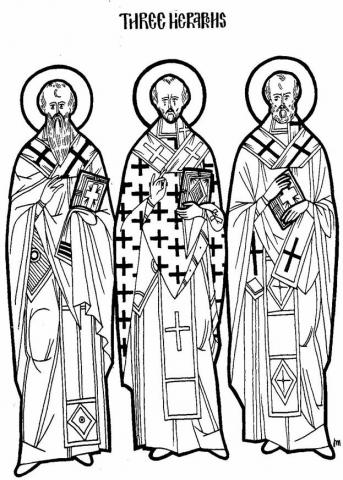
St. Cyril of Alexandria
ST. CYRIL OF ALEXANDRIA
Objectives:
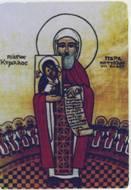 Students should know who he was and what he did.
Students should know who he was and what he did.- Students should know the word, “Theotokos”, and what it means.
Possible Lesson Plan:
- Open with prayer.
- Read the story of St. Cyril of Alexandria:
Cyril was born in Alexandria in Egypt nearly 400 years after the time of Jesus. (Do you remember any other things that happened in Egypt? Joseph, Moses, etc.) His uncle was bishop of Alexandria. Cyril was not really a very nice boy – he like to fight and argue, even with his friends. But he loved the Lord and tried to serve God all his life.
When Cyril grew up, he became bishop, or “patriarch”, of Alexandria. The bishops of the five largest churches were often called patriarchs. Can you name these big cities of the ancient world? Rome, Constantinople, Antioch, Alexandria, and Jerusalem. Can you say the word, “patriarch”?
There was, at the same time, in Antioch, a bishop named Nestorius who came up with a very upsetting new teaching. He decided that Mary could not really be the mother of God but only the mother of Christ, the man. Again, someone was trying to split Jesus up into two people, God and man. Who else had a false teaching along the same lines? (Arius) We call Mary “Theotokos”, meaning “mother of God”. But Nestorius wanted to call her “Christotokos” instead. The emperor called another big council of bishops, this time in the city of Ephesus. Cyril argued for Mary to be called “Theotokos” and Nestorius argued for “Christotokos”. But, after Cyril’s explanation, Nestorius agreed that Mary should be called “Theotokos”, as she is to this day. Can you say the word? Do you know what it means? Because of the faith of St. Cyril of Alexandria, we call Mary “Theotokos” and honor her as the mother of God.
Add St. Cyril to your timeline.
- True/False Questions:
True False
Cyril was bishop of Alexandria. Cyril was bishop of Constantinople.
Cyril believed Mary was Theotokos. Nestorius believed that Mary was Theotokos
Nestorius believed Mary was Christotokos. Cyril believed Mary was Christotokos.
Theotokos means “mother of God”. Theotokos means some old lady.
- Discuss mothers: Let children share about their mothers. What characteristics does a mother have? What does she do for/with her children? Jesus was a baby and a child. What would Mary have done for Him? How do we honor our mothers? (e.g. Mother’s Day) Mary was even more – she was “Theotokos”. Review the word and its meaning. How did she become the Mother of God? Review the story of the Annunciation; look at the picture in the Bible storybook. How did Elizabeth, her cousin, honor Mary? How should we honor Mary? Practice venerating an icon of Mary. Let each child bow and cross himself and kiss the icon.
- Make the icon of the Theotokos. See pattern next page. If you don’t want to do the three layers, you can use glitter glue for the halos and decorate paper plate as frame.
- Close with prayer: Lord, we worship You and honor Your mother, Mary, the Theotokos. Remind children to put the icon of the Theotokos in their icon corner this week; can they put flowers to honor her?
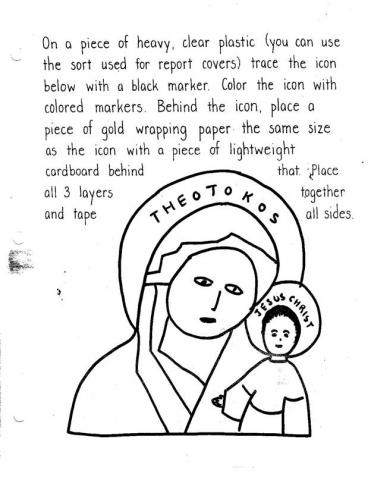
Evangelization: St. Patrick
ST. PATRICK, BISHOP OF IRELAND
Objectives:
- Students should know his name and be able to tell his story.
- Students should know why St. Patrick is the patron saint of Ireland.
Possible Lesson Plan:
- Open with prayer.
- Tell the story of St. Patrick:
Patrick was born in the south of Britain around 400 years after the time of Jesus. His father was a deacon and his grandfather a priest. Patrick, though, was a disobedient little boy – not close to the Lord at all! But, when Patrick was 16 years old, he was captured by a band of Irish slave traders and sold as a slave to a shepherd. He had to stay alone in the mountains with the sheep and there began to pray and grew close to God.
After six years as a slave, Patrick heard a voice telling him to escape to the south and he would be able to get to England. He escaped and walked 200 miles, where he caught a boat just before it left. But the boat was going to France! The boat landed in France, but the barbarians had been there too, leaving the land without people or food. Patrick and the other people were soon starving. But, Patrick prayed and that very day a herd of wild pigs came across their path, giving them plenty of meat. Patrick was able to go home to his family in Britain.
But soon Patrick again had a vision; he heard the voices of the Irish people begging him to come to them. He studied this time in France in a monastery and then was ordained a bishop and went to Ireland. He was given land and a barn by a man named Dichu; this became his church.
Patrick traveled all over Ireland. Once he stopped at a hill where the king was having a feast. It was Pascha and Patrick lit a fire, just like we light candles. The king’s daughters became Christians. Patrick taught them about the Holy Trinity by using the shamrock (3-leafed clover). Just as there are 3 leaves in one shamrock, so there is one God with 3 Persons. (Can you name the Persons of the Holy Trinity?) A story is also told that Patrick prayed and all the snakes were driven out of Ireland. Because of these two events, Patrick is always pictured holding a shamrock with snakes slithering away from him!
Soon there were so many Christians in Ireland that more priests and bishops were needed. Patrick built many churches and monasteries. He is remembered on March 17.
Add St. Patrick to your timeline.
- True/False Questions:
True False
Patrick was captured and taken to Ireland. Patrick was born in Ireland.
Patrick was a shepherd in Ireland. Patrick was a lion-tamer in Ireland.
Patrick had a vision telling him to go back Patrick hated Ireland and never went back.
to Ireland.
Patrick used the shamrock to tell about the Patrick taught about the Trinity with a
Trinity. snake.
Patrick drove all the snakes out of Ireland. Patrick drove all the pigs out of Ireland.
- Talk a bit about the Holy Trinity. Who are the three Persons? Practice making the sign of the cross; what do the three fingers stand for? Practice saying “in the name of the Father, and of the Son, and of the Holy Spirit” while making the sign of the cross until all the children can do it neatly. Do they remember what the 2 fingers lying against the hand mean? (the 2 natures of Christ, come to earth) Look at a shamrock (Have a picture ready or cut one out of green paper.) Just as St. Patrick did, show how there are three leaves in one shamrock. So there are three Persons in one God. Try this little song to the tune of “Are you sleeping?”:
God the Father, God the Father,
God the Son, God the Son,
God the Holy Spirit, God the Holy Spirit,
Three in one, Three in one.
- Shamrocks and snakes would make great crafts today. A great snake can be made from Rigatoni noodles, painted different colors and strung on a piece of yarn. Shamrocks out of green construction paper can be decorated; could you make St. Patrick’s Day cards to take to the nursing home? There are also dozens of great crafts for St. Patrick’s Day in catalogs like Oriental Trading, often using green foam shamrocks. Make a doorknob hanger with green foam shamrocks of ever smaller size strung on a piece of green yarn; the top one can be large enough to cut a doorknob size hole or tie the yarn around the doorknob. Pictures of things important to the story of St. Patrick can be glued to each foam shamrock – a sheep, a pig, a snake, a princess’s crown, etc. We also have icon bulletin covers of St. Patrick for your nursing home cards or largest foam shamrock. Want something simpler? But still focus on the shamrock and the Trinity: Take a green foam shamrock, or a wooden shamrock painted green. Cut out the figure of St. Patrick from the icon above and glue in the center. Then use stickers or cut out shapes for heart for the love of the Father, cross for the Son, and dove for the Holy Spirit. Finally, add a ribbon and done!
- Close with prayer: Lord, help me to trust you even when bad things happen, as did St. Patrick.
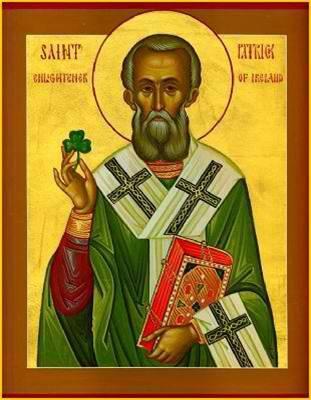
F
Fall of Rome
FALL OF ROME
Objectives:
- Students should know that the capital of the Western Empire was the city of Rome.
- Students should know the story of St. Leo, bishop of Rome, and Attila the Hun.
- Students should know the name of the new capital of the Roman Empire, Constantinople.
Possible Lesson Plan:
- Open with prayer.
- Tell the story of the fall of Rome:
Do you remember the Emperor Constantine? He founded a new city, named for himself, Constantinople and moved the capital of the Roman Empire to his new city, far to the east of Rome. The new city was Christian from the start, full of churches. Councils were held here. Do you remember that St. John Chrysostom was bishop of Constantinople.
Far to the west, in Rome, things were not going so well. Many wild tribes lived to the
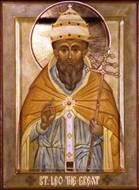 north. They were fierce warriors and knew nothing of Christianity or the great Roman cities and culture. They were called “barbarians” by the Romans because they didn’t even speak Latin or Greek. Their speech sounded to the Romans like “bar bar bar.” They lived in little villages and tribes. But, they wanted more and more land. One of these tribes was called the Huns; their chief was Attila the Hun. Can you say that? They were wild and fierce and rode little, hairy ponies. Attila moved his army down Italy toward Rome itself. They burned and destroyed everything in their way. Finally they were at the gates of Rome. The bishop of Rome in that day was named Leo I (the first). Leo means “lion” but this Leo was not a soldier or a fighting man. But he wanted to save his city and his people. He went out the gates of the city, dressed in his gorgeous robes, with all the bishops and priests. He carried no shield or sword or spear. Would Attila and his men slaughter them like lambs before the wolves? Attila and Leo met outside the walls of Rome. Then, Attila and his army turned around and left Italy – marched away without even entering the city or killing anyone. Leo may not have been a fighting man, but he had the courage of a lion!
north. They were fierce warriors and knew nothing of Christianity or the great Roman cities and culture. They were called “barbarians” by the Romans because they didn’t even speak Latin or Greek. Their speech sounded to the Romans like “bar bar bar.” They lived in little villages and tribes. But, they wanted more and more land. One of these tribes was called the Huns; their chief was Attila the Hun. Can you say that? They were wild and fierce and rode little, hairy ponies. Attila moved his army down Italy toward Rome itself. They burned and destroyed everything in their way. Finally they were at the gates of Rome. The bishop of Rome in that day was named Leo I (the first). Leo means “lion” but this Leo was not a soldier or a fighting man. But he wanted to save his city and his people. He went out the gates of the city, dressed in his gorgeous robes, with all the bishops and priests. He carried no shield or sword or spear. Would Attila and his men slaughter them like lambs before the wolves? Attila and Leo met outside the walls of Rome. Then, Attila and his army turned around and left Italy – marched away without even entering the city or killing anyone. Leo may not have been a fighting man, but he had the courage of a lion!
Soon after, the Vandals, another wild tribe, captured northern Africa. A man named Augustine was Bishop of the city of Hippo at this time. Augustine had been a great teacher and writer of the western Church. But, Augustine was old and ill and died while the Vandals were attacking the city. They sailed up the Tiber River to Rome. They captured the city and stole all its treasures! Then another tribe called the Teutons divided up the empire. Just like Humpty Dumpty, Rome had a great fall – broken into many pieces by the barbarian tribes and never to be put back together again. Each tribe had its different customs and wanted to rule its land in its own way. The last Emperor was named Romulus Augustulus. Old Rome was beaten. It was the year 476 AD. But, the Empire in the East, with its capital in the great city of Constantinople, would continue for another thousand years.
Add St. Leo the Great to your timeline.
- True/False Questions:
True False
Leo was the bishop of Rome. Attila was the bishop of Rome.
Attila was the chief of the Huns. Attila was a lion.
Leo turned Attila away from Rome Leo fought a great battle with Attila.
without fighting.
Leo means “lion”. Leo means “monkey”.
- Try reinforcing this lesson with a little ditty to the beat of “Humpty-Dumpty”:
Good old Rome had very strong walls.
Good old Rome had a great fall.
Vandals and Teutons and Attila the Hun
Couldn’t put old Rome together again.
- Another song can teach the first 5 Patriarchates, to the tune of “Row your Boat”:
Chorus: Five centers in the Church, in the early Church;
Preaching, teaching, praying, sharing, in the early Church.
- Way out, to the west, was the Church of Rome;
Preaching, teaching, praying, sharing, was the church of Rome.
- Constantinople had the Church, “Holy Wisdom”,
Preaching, teaching, praying, sharing, “Haggia Sophie”.
- All “Christians” got their name, out of Antioch;
Preaching, teaching, praying, sharing, all in Antioch.
- The very first church of all, was in Jerusalem;
Preaching, teaching, praying, sharing, in Jerusalem.
- Last of all was Egypt’s church, in Alexandria;
Preaching, teaching, praying, sharing, in Alexandria.
- Discuss courage: What’s a lion like? Have the students come up with some characteristics of a lion. Look at a picture of a lion. How was Leo like a lion? How different? Ask the students if they have ever met a bully – someone who was mean and nasty to them. Were they afraid of the bully? What did they do – run and hide? Fight? How did Leo face Attila the Hun? Do you suppose he was afraid? Did he run away? What would have happened if he had run away? Did he fight? Would he have won if he had?
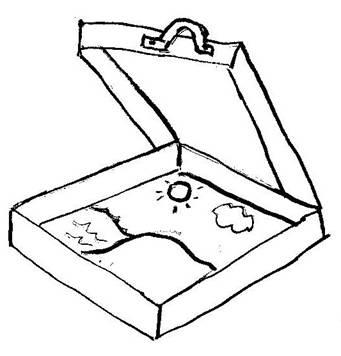
- Make a Flannel Board pizza box: Take a pizza box; most stores will give these to you. Glue light blue felt on the inside back; add cotton ball clouds in the sky and green felt grass along the bottom. Make a gray felt wall and draw stones with a marker; this can sit above the grass. Have students draw Leo in his bishop’s robes, Attila the Hun, and Attila’s horse of construction paper. Color and cut out. Glue strips of felt on the back of each figure. Can you tell the story?
8. Alternate Craft Idea: Too involved? Try this simpler craft: Make a coat of arms for Leo’s bishop’s hat. Cut two bishop’s hat shapes out of tagboard, foam, or construction paper. Staple together to make a hat. On one side, glue a cross cut from construction paper. On the other, glue a golden lion cut from gold wrapping paper. Review how the cross and the lion are involved in the story of Leo and Attila the Hun.
9. Close with prayer: Lord, help me to trust You whenever someone is mean and nasty.
Justinian and the Byzantine Empire
THE BYZANTINE EMPIRE UNDER JUSTINIAN
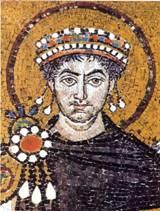 Objectives:
Objectives:
- Students should know the name of the Byzantine Empire and its capital, Constantinople.
- Students should be able to name Justinian as a wise Emperor and list 2-3 of his accomplishments.
Possible Lesson Plan:
- Open with prayer.
- Tell the story of the Byzantine Emperor and Justinian:
About 50 years after the fall of Rome, Justinian became emperor in the East. In this day, Constantinople was the greatest city in the world. The waters around the city were filled with boats; it had high walls to protect it from enemies. People came from all over the world to see the beautiful city and study in its many famous schools and worship in its churches. Justinian saw his city as the Second Rome, greater and finer than Rome ever was.
Justinian also began to collect all the laws of his land. Until this time, each city and state had its own rules and judges. Justinian sent wise lawyers throughout the land and gathered all these laws. They chose the best from each city and wrote a law that would be true throughout the land, the Code of Justinian.
Justinian wanted to take back the lands of the west that had been lost to the barbarians. He first sent his mighty army against the Vandals in North Africa. He took back northern Africa and went from there to Italy and southern Spain. His empire went around the Mediterranean, although he never retook France or England.
Justinian also had architects throughout his empire build beautiful churches. The greatest of these was Haggia Sophia, the Church of the Holy Wisdom, in Constantinople. This magnificent church is topped with a huge dome. Artists painted beautiful icons and worked mosaics of tiny pieces of stone and glass. A mosaic could cover the entire wall of a church or monastery. Goldsmiths made beautiful jewelry set with precious stones. The Byzantine Empire became the art and cultural capital of the world.
Add Justinian the Great to your timeline.
- True/False Questions:
True False
Justinian was Emperor of Constantinople. Justinian was Emperor in Rome.
The Code of Justinian is made of laws. The Code of Justinian is used by spies.
Justinian took back Italy and north Africa. Bishop Leo took back Italy and Africa.
Haggia Sophia means Holy Wisdom. Haggia Sophia is a girl’s name.
Haggia Sophia is a church. Haggia Sophia is a piece of furniture.
- Get a book from the library and show some pictures of Haggia Sophia and Constantinople (now called Istanbul). Look at pictures of the beautiful mosaic work in Byzantine style – e.g. St. Mark’s in Venice. Do you see how, with the different colors and background fitted together, a beautiful design or picture can be made?
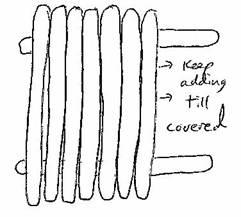
- Make a real mosaic cross trivet: First make the base of Popsicle sticks; lay 2 on the table about 3 inches apart and parallel. Cover top of each with glue. Lay others perpendicular from one end to the other to make a smooth work surface. Now cover your base with glue. Take small colored pieces of broken tile or small tiles and shape a cross or other picture. Fill in the rest of the square with white tiles. After it dries, spread grout in the cracks; wipe with damp cloth to get film of grout off the tiles before it dries. These can be used for years as a small piece of Byzantine beauty.
- Close with prayer: Lord, give me a love of the beauty of Your Church as Justinian had.
Rise of Islam
RISE OF ISLAM
Objectives:
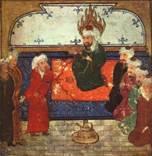 Students should be able to name Mohammed as the founder of Islam.
Students should be able to name Mohammed as the founder of Islam.- Students should be able to name “Allah” as the god of Islam.
- Students should know that the book of Islam is called the “Koran”.
- Students should know that followers of Mohammed are called Moslems (or Muslims).
Possible Lesson Plan:
- Open with prayer.
- Tell the story of Mohammed – have pictures of deserts and camels to show:
In the world of the Arabs in northern Africa, a world of camels and deserts, there arose a new teacher. His name was Mohammed. Mohammed was born in the city of Mecca about 600 years after the time of Jesus. He was just a poor camel driver, a servant of a wealthy Arabian lady. The lady fell in love with the servant and they were married. And for many years, the camel driver and his wife lived a quiet life in the town of Mecca. Then, when he was forty years old, Mohammed thought that an angel told him that he should write a new book of teachings about a god he called Allah. He called his book the Koran. Mohammed did not believe that Jesus was the Son of God or that Jesus rose from the dead. In fact, Mohammed believed that he himself was greater and wiser than Jesus! His wife believed Mohammed and became his first follower.
At first, the Arabic people laughed at Mohammed and plotted to get rid of Mohammed. But, Mohammed heard of the plot to kill him, and ran away with his wife and friends. He fled to the town of Medina. For awhile Mohammed taught his new ideas in the city of Medina. He called his new religion Islam and his followers were called Moslems. But soon, Mohammed was not happy to have only the followers who liked his new teachings. He told all of his followers that they would go right to heaven if they were killed following him in battle. They began to force people in Arabia and in other lands to become Moslems or die. Soon, Mohammed and his followers conquered all of Arabia. Mohammed died, but his followers continued to fight wars to conquer lands for their new ideas. They traveled to Persia, to all of northern Africa, to Spain and to France, conquering the Christian lands, until they were stopped in France by the great warrior, Charles the Hammer, at the Battle of Tours. They even conquered Jerusalem and the Holy Land where Jesus had taught and lived! Soon they were at the doorstep of Constantinople, the capital of the great Christian Byzantine Empire built by the Emperor Constantine 400 years before.
For many years the Arabic followers of Mohammed tried to conquer Constantinople. Battle after battle was fought. The people of Constantinople poured boiling oil on the attacking Moslems. Finally, Emperor Leo III defeated the Moslems in 717 AD and made them flee behind the mountains. They did not attack Constantinople again for hundreds of years. Christians were safe to worship the Lord in the lands of the Byzantine Empire again.
Add the Muslim invaders to your timeline.
- True/False Questions:
True False
Mohammed lived in Arabia. Mohammed lived in Rome.
Mohammed’s new god was called Allah. Mohammed’s new god was called Pharaoh.
Mohammed’s followers are called Moslems. Mohammed’s followers are called camels.
Mohammed’s holy book is called the Mohammed’s holy book is called Harry
Koran. Potter.
- Who were the Arabs? Remind the students of the story of Abraham, and his sons Ishmael and Isaac. Look at the pictures in their picture Bibles and retell the story. The Arabs were the great-great-great-great…grandchildren of Ishmael, who fled with his mother Hagar into the desert. The children of Isaac became what people? (the Jews or Hebrews) Look at pictures of Arabic life – of camels, tents, deserts.
- Make a camel: Cut two bumps from an egg carton. Poke six holes for legs, head, and tail. Use pipe cleaners for legs and head/tail combination. Paint whole animal brown if desired.
- Close with prayer: Lord, help me not to be led away from You by false teachers with new ideas.
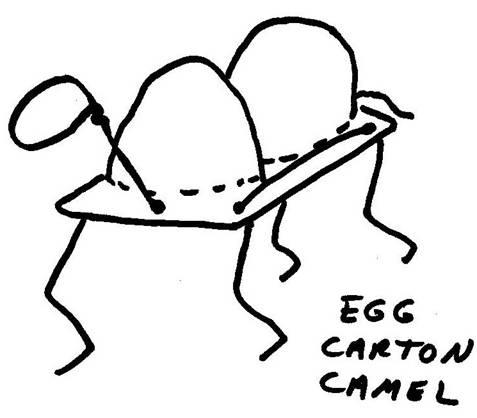
Sunday of Orthodoxy and St. John of Damascus
SUNDAY OF ORTHODOXY/ST. JOHN OF DAMASCUS
Objectives:
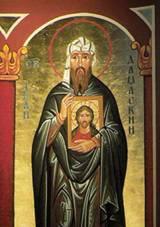 Students should be able to say “Sunday of Orthodoxy” and know that we celebrate the return of the icons to the church.
Students should be able to say “Sunday of Orthodoxy” and know that we celebrate the return of the icons to the church.- Students should know what an icon is.
- Students should know that the Empress Theodosia and St. John of Damascus fought for the return of the icons.
Possible Lesson Plan:
- Open with prayer.
- Tell the story of the Sunday of Orthodoxy:
From its earliest days, Christians made pictures of Jesus, Mary, and important events in Christian history. They drew them on the walls of their tombs, deep in the catacombs under the city of Rome. They drew on the walls of their churches and monasteries. Most people could not read in those days. They did not worship these pictures but used them as “windows to heaven” – to remember the life of Jesus, His teachings, and the lives and teachings of His holy ones, the saints.
But, there came a day about 700 years after the time of Jesus, when a wicked emperor in Constantinople, another Leo, decided to get rid of the icons. He, and later his son, another Constantine, burned the monasteries and killed the monks and looted the churches, trying to destroy all the icons. Icons were hidden to keep them safe.
At this time, there lived in Damascus, a city under the rule of an Arab caliph (or king), a man named John; we know him now as John of Damascus. John was wise and charming; soon he was the caliph’s second-in-command. The caliph was a Moslem, but John was a Christian. John taught and wrote about his love of icons. Emperor Leo did not like this and tried to have John killed. He told lies to the caliph, saying John was going to betray him to the Greeks, and the caliph believed Leo. He had John’s hand cut off. John prayed and his hand was healed! Then John left the palace and went to live in a monastery. There he wrote many hymns and prayers and even invented the series of eight tones for singing we use today in church.
Finally, the Empress Irene called for a council of the bishops. This was the seventh and last church council. The church stood firmly for bringing the icons back! But, the emperors were still opposed. Finally, the Empress Theodosia brought the icons back into the churches. There was such rejoicing. And, to this day, we celebrate the return of the icons with a great procession of icons on the “Sunday of Orthodoxy”.
Add St. John of Damascus to your timeline.
- True/False Questions:
True False
Icons are “windows to heaven”. Icons are pictures of pigs.
Emperors Leo and Constantine burned Emperor Leo loved icons.
Icons and killed monks.
John of Damascus loved icons. Emperor Leo loved John of Damascus.
Empress Theodosia brought the icons Emperor Constantine brought the icons
back into the churches. back into the churches.
Sunday of Orthodoxy celebrates the Pentecost celebrates the return of the icons.
return of the icons.
- Discuss icons: What are they? Let the students discuss a bit. A display of icons or pictures of famous icons will help. How are they different from other pictures? How do we venerate an icon? (practice kissing and making the sign of the cross) Where do we put it? Does the student have an icon corner in his home? In his room? Maybe this would be a good time to start. Take an icon of a feast and show how it tells the story of the feast. Could someone learn this story even if he couldn’t read? Do any of the students remember how we celebrate the Triumph of Orthodoxy? Have they marched with the priests and other children around the church carrying their icons?
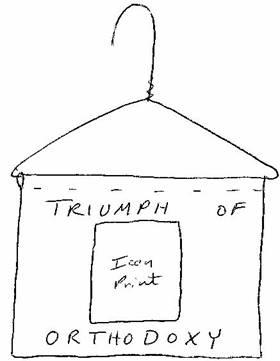 Make a Triumph of Orthodoxy Banner: Take a piece of felt. Staple one end over a wire hanger. Glue on an icon print; we have a vast array of old bulletin covers. Write with magic marker or felt letters “Triumph of Orthodoxy”.
Make a Triumph of Orthodoxy Banner: Take a piece of felt. Staple one end over a wire hanger. Glue on an icon print; we have a vast array of old bulletin covers. Write with magic marker or felt letters “Triumph of Orthodoxy”.
- Close with prayer: Stand before your class icons and venerate first, then pray, Lord, may I honor Your life and Your Mother and all Your Saints each day of my life.
Monasticism: St. Gerasimus
MONASTICISM/ST. GERASIMUS
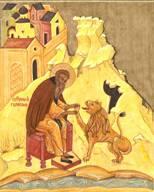
Objectives:
- Students should be able to say the word “monasticism” and to know a little about the life of a monk.
- Students should be able to tell the story of St. Seraphim and say his name.
Possible Lesson Plan:
- Open with prayer.
- Tell the story of St. Gerasimus:
St. Gerasimus left his home to live as a hermit. Do you know what a hermit is? A hermit lives all alone, in silence and prayer, with only a little food and a hard cave or hut to sleep in. Some hermits come together on Sundays for liturgy. No one in a hermitage owns anything except one set of clothes, a pot for water and a mat to sleep on.
St. Gerasimus lived for many years as a hermit. He was a kind and gentle man. Animals loved St. Gerasimus. One day, a sick lion with a thorn in its paw visited St. Gerasimus. The saint pulled out the thorn and bathed and bandaged the swollen paw. The lion became his friend and followed the saint like a dog. Each day the lion was told to go with the donkey on its trip to the Jordan River for grazing and water and guard the donkey. But, one day, the lion fell asleep. A caravan of merchants came by and saw the donkey, seeming to be all alone. They took the donkey and rode off. When the lion woke up, he was ashamed and went back to St. Gerasimus without the donkey. The saint thought the lion had eaten the donkey! After that, the lion would carry the barrel of water that the donkey used to carry. One day, a soldier bought the monastery a donkey and the lion was set free.
Much later, the caravan of merchants who had taken the donkey passed by again. The donkey was leading three camels loaded with goods. Suddenly, a lion leaped out and grabbed the donkey’s halter with its teeth. The merchants and camels ran away in fear. The lion led the donkey back to the monastery. The camels, loaded with wheat, followed the donkey and the lion. St. Gerasimus told the lion he was sorry he had accused him unjustly of eating the donkey.
The lion stayed with the monks until the death of St. Gerasimus. It went to the grave of its friend and roared and roared. Then it lay down and died.
Add St. Gerasimus to your timeline with his lion.
- True/False Questions:
True False
St. Gerasimus was a hermit monk. St. Gerasimus was a king.
A lion was the saint’s friend. St. Gerasimus was a lion.
The lion brought back the donkey. The lion ate the donkey.
- Discuss monastic life: What is a monk? How does a monk live? Some live alone and some in communities called monasteries. Repeat the words “monk” and “monastery.” Ask the students what a typical day in their lives is like – what do they do, eat, wear, type of home, etc. Now take a monk in a monastery and contrast each aspect. Then a hermit. Try a game of “silence”; how long can the students stay silent?
- Make a handprint lion and footprint donkey. Have each child trace one hand and one foot on a piece of paper. Add mane, eyes, mouth for lion and ears, eyes, nose for donkey. Color and label “The Friends of St. Gerasimus”.
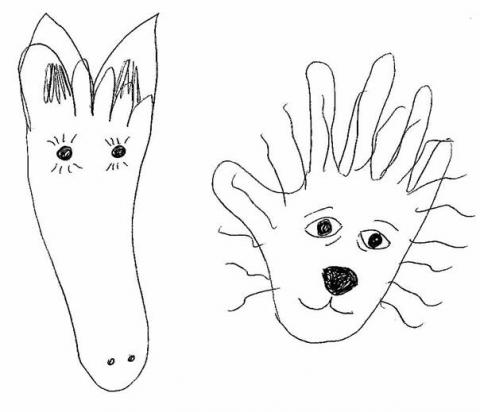
- Close with prayer: Lord, I ask St. Gerasimus to pray for me that I will grow closer to You every day.
Sts. Cyril and Methodius and the Baptism of Russia
ST. CYRIL AND METHODIUS/BAPTISM OF RUS
Objectives:
- Students should know the names Cyril and Methodius and that they told the people of Rus about Jesus.
- Students should know the names of King Vladimir and Queen Olga, the first Christian rulers of Rus.
- Students should know that the people of Rus, in what is now Ukraine, spread the gospel far and wide to what is now Russia, Ukraine, and Belarus.
Possible Lesson Plan:
- Open with prayer.
- Tell the story of the Baptism of Rus:
In the city of Thessalonica lived two brothers named Constantine and Methodius. Can you say their names? Practice a few times. They lived about 800 years after the time of Jesus. They had friends who were Greek and friends who were Slavic, from countries to the north who spoke a different language. Methodius became governor of a province in Asia and Constantine went to Constantinople to work for the Patriarch. But, soon both brothers decided to become monks.
Later the king of the Khazars, in southern Slavic lands, sent a messenger to the Emperor asking for someone to be sent who could tell them about the Christian faith. The people were confused by so many different religions. Constantine and Methodius left their monastery and went to Russia. There they taught the king all about the Christian faith. Many people were baptized. Finally, the brothers headed back to Constantinople. They went back to their monastery.
The next year, another messenger came, this time from the land of Moravia. The king there wanted someone to come who could teach the people in their own Slavic language. The emperor immediately thought of Constantine and Methodius, who learned from their friends in childhood. But, how to teach in the Slavic language? There was no alphabet for the sounds, so Constantine had to make up an alphabet to write down the teachings of Jesus. Then, the brothers wrote down the liturgy and parts of the Bible in the new alpha
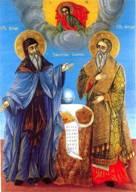 bet. When they got to Moravia, they taught the people to read in their own language and started churches with liturgy in their own language. After several years, the brothers went back to the monastery. Constantine was very sick, and was tonsured a monk and given the name of Cyril. So the alphabet he invented is known to this day as the Cyrillic alphabet. Cyril died soon after, and Methodius went back to the Slavic countries as a bishop. He started more churches and trained Slavic priests. The Slavic people were so happy to have their own alphabet and Bible and Liturgy books. Finally, as an old man, Methodius died, still serving Jesus in the Slavic countries.
bet. When they got to Moravia, they taught the people to read in their own language and started churches with liturgy in their own language. After several years, the brothers went back to the monastery. Constantine was very sick, and was tonsured a monk and given the name of Cyril. So the alphabet he invented is known to this day as the Cyrillic alphabet. Cyril died soon after, and Methodius went back to the Slavic countries as a bishop. He started more churches and trained Slavic priests. The Slavic people were so happy to have their own alphabet and Bible and Liturgy books. Finally, as an old man, Methodius died, still serving Jesus in the Slavic countries.
Even farther north, in deepest Rus, lived a queen named Olga. Olga made a visit to Constantinople and became a Christian and was baptized. But her people were still worshipping gods made of wood. Soon her grandson, Vladimir, became prince. He was not sure what religion was true. So Vladimir sent a group of men to each country to see if its religion was true. The men found beauty and truth in the Christian churches of Constantinople. But, Vladimir was still not sure what was best for his people. Vladimir offered to marry the sister of the Emperors Basil and Constantine. Her name was Anna. Anna did not want to go to Rus, but hoped that she could help the land of Rus to believe in Jesus. Vladimir, meanwhile, had gone blind; he could not see. He was told that he would not see until he was baptized. Vladimir decided this would be a test to prove the true God and was baptized. He was healed!
Now Vladimir wanted his people to know the true faith also. He burned their idols of wood – nothing happened. These were false g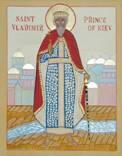 ods with no power. Then he told all the people, rich and poor, young and old, to meet him on the banks of the Dneiper River the next morning. Prince Vladimir told them all about Jesus and their need to be baptized. They waded right into the river -- mothers, fathers, children, babies – all were baptized that day. So Vladimir is remembered as the “Baptizer of Rus”, equal to the apostles. The people of Rus, now Ukraine, spread the faith throughout what is now Russia, Ukraine, and Belarus.
ods with no power. Then he told all the people, rich and poor, young and old, to meet him on the banks of the Dneiper River the next morning. Prince Vladimir told them all about Jesus and their need to be baptized. They waded right into the river -- mothers, fathers, children, babies – all were baptized that day. So Vladimir is remembered as the “Baptizer of Rus”, equal to the apostles. The people of Rus, now Ukraine, spread the faith throughout what is now Russia, Ukraine, and Belarus.
Add Sts. Cyril and Methodius and Sts. Vladimir and Olga to your timeline.
- True/False Questions:
True False
Cyril made a new alphabet for the Slavs. Cyril made the Slavs learn Greek.
Cyril and Methodius were brothers. Cyril and Methodius were father and son.
Queen Olga of Rus became a Christian. Queen Olga of Rus worshipped idols.
Prince Vladimir baptized Rus. Queen Olga baptized Rus.
- Work on the difficult names of these important saints: Cyril (originally Constantine), Methodius, Vladimir, and Olga. Does any student or their relative have one of these names; what about Walter, the English name for Vladimir? Which ones were missionaries/evangelists? Which were rulers? Which were monks?
- Make 2 stand-up puppets, a king and a queen. Print Vladimir and Olga on white or cream cardstock. Cut the bodies out of white and decorate with gold glitter glue crowns, color faces, yarn for hair or beard if desired. Cut robes from colored construction paper. Glue body inside center section of robe. Fold robe sides.
- Close with prayer: Lord, help me to love people who are different from me and speak other languages and to tell them about Jesus and bring them to Church to hear about You.
St. Gregory Palamas
ST. GREGORY PALAMAS
Objectives:
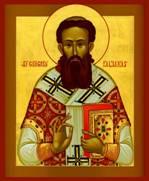 Students should know his name and be able to tell his story briefly.
Students should know his name and be able to tell his story briefly.- Students should know that Gregory defended the Holy Spirit in the Trinity.
- Students should memorize the Jesus Prayer.
Possible Lesson Plan:
- Open with prayer.
- Tell the story of St. Gregory Palamas:
Gregory was born in the royal city of Constantinople more than a thousand years after the time of Jesus. At age 7, both of his parents died, and Gregory was an orphan. But, the orphan boy was a favorite of Emperor Andronicus II, who sent the boy to school, where Gregory studied all about science. Science, however, did not interest Gregory; his interest was in the Lord Jesus. He soon began studying about the Lord and gave up his life in the court of the emperor to spend his time in monasteries.
When Gregory was 30 years old, he became a priest. He had learned well from the monks around Constantinople and Mt. Athos. They had taught him the Jesus Prayer. The monks would bow in prayer, concentrate on the Lord, and recite, “Lord Jesus Christ, Son of God, have mercy upon me, a sinner.” As the monk prayed and prayed, over the years he would grow closer to the Lord and experience the light of the closeness of Jesus. With Jesus as the sun, Gregory and the other monks could feel the light and warmth of His shining rays.
But, in those days, a man named Barlaam was teaching also. Barlaam had never been a monk; he had studied about Jesus but had not spent years in prayer just getting to know Jesus. In fact, Barlaam didn’t believe that people could get to know Jesus, not to really feel Him near, until after they died. He made fun of the monks and called them “Belly—button-gazers” because they spent so much time kneeling and bowing in prayer.
Gregory knew that Barlaam was wrong. Gregory knew Jesus in his heart and had felt His presence with him. Gregory had seen and felt the light of God -- the same light that St. Stephen saw as he was being stoned, that St. Peter saw when Jesus was transfigured on the mountain, and that St. Paul saw on the road to Damascus. He knew that the Lord was present with all of His followers since the coming of the Holy Spirit at Pentecost. This Holy Spirit, the same Spirit who appeared from heaven when Jesus was baptized in the form of a dove, was just as much a part of God as God the Father or God the Son, Jesus. Gregory defended the monks and their vision in his teachings as a priest and in his writings. He told the world that Barlaam was wrong -- that every Christian can draw near to God through prayer.
Later in life, Gregory was made Archbishop of Thessalonica. He suffered many times because of his teachings; he was thrown out of his home, was thrown in prison, and was even captured by the Moslem Turks. But, finally, before his death, two church councils in Constantinople held firm for Gregory’s teachings and told all of us that we can know and feel the presence of God in our daily lives.
Add St. Gregory Palamas to your timeline.
- True/False Questions:
True False
Gregory was a monk. Gregory was a monkey.
Gregory taught the Jesus Prayer. Gregory hated Jesus.
Gregory loved the Holy Spirit. Barlaam loved the Holy Spirit.
- First discuss the Holy Spirit: Review the stories of the dove at Jesus’s baptism, the tongues of fire at Pentecost, the Transfiguration, the death of Stephen, and the conversion of Saul. These are in the students’ story Bibles. Who are the persons of the Holy Trinity? Remember the sign of the cross and the three fingers, the shamrock and the three leaves. Can you feel Jesus in your heart, as did Gregory Palamas?
- Make a Gregory Palamas bookmark: Copy the front and back together on cardstock, fold, and glue together. Punch hole in top. After children color the figures, use Contac paper (clear) or laminating sheets to waterproof. Pair of ribbons through the hole to complete the bookmark.
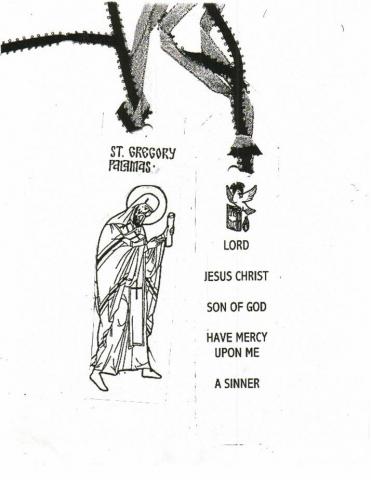
- Close with prayer: Practice bowing and saying the Jesus Prayer with the children until they know it by heart!
T
Crusades
THE CRUSADES
Objectives:
- Students should know the word, crusade, and that these were wars to take the Holy Land from the Moslems.
- Students should know that the crusaders did not win the Holy Land for Christians in the end.
- Students should know that the crusaders broke into the city of Constantinople and killed its Christian people and stole its treasures.
Possible Lesson Plan:
- Open with prayer.
- Tell the story of the Crusades:
We studied in an earlier lesson how the followers of a man named Mohammed conquered the Holy Land and the city of Jerusalem, the land where Jesus had lived, died, and was buried. Do you remember the story of Mohammed, the camel driver? What were his followers called? All thru the ages, Christians from all over the world would come to see the places where Jesus had lived, but these lands were now in the hands of Moslems.
Christians in the Western lands of Europe were very angry about the rule of the Moslems in the Holy Land. The Bishop of Rome, called the Pope (or Big Dad) by the Western Christians, called on his people to leave their homes and families behind and go to attack the Moslems. These new soldiers sewed great crosses on their clothes and painted them on their shields and armor; they were called Crusaders. Can you say Crusade? This means a war for the cross. Before long, thousands and thousands of people, young and old, men and women had joined the Crusade to go to Jerusalem. Poor people left their farms and huts, nobles and princes left their castles. Some rode on horses; some walked by foot. They traveled for four years and finally reached the walls of Jerusalem. There they thanked God for bringing them safely to the end of their journey and then they attacked the city. The first Crusaders captured Jerusalem! They built castles and claimed the land for themselves. They even had their own king.
But, soon the Moslems won the city back. It didn’t stay captured for many years. So, over the next two hundred years, every so often there would be another Crusade. Sometimes the Western Christians would win the city back again, but not for long; sometimes they didn’t win it back at all.
 The Third Crusade was a famous one – three kings led the Crusade. Frederick Red Beard of Germany started out, but drowned in a river along the way. Philip of France ran away back home because he was jealous of the third king. The third king was Richard of England. He was known as Richard the Lion-Hearted and loved by all. In fact, Richard even made friends with Saladin, the Moslem ruler of Jerusalem, who decided to let the Crusaders worship at Jesus’s tomb without even fighting with them! But, on the way home, Richard was captured by his enemies. He took so long coming home, that Robin Hood had to save England from his wicked brother, Prince John. Do you know the story of Robin Hood and his merry men? Did you know that the Crusades were the reason for King Richard’s disappearance?
The Third Crusade was a famous one – three kings led the Crusade. Frederick Red Beard of Germany started out, but drowned in a river along the way. Philip of France ran away back home because he was jealous of the third king. The third king was Richard of England. He was known as Richard the Lion-Hearted and loved by all. In fact, Richard even made friends with Saladin, the Moslem ruler of Jerusalem, who decided to let the Crusaders worship at Jesus’s tomb without even fighting with them! But, on the way home, Richard was captured by his enemies. He took so long coming home, that Robin Hood had to save England from his wicked brother, Prince John. Do you know the story of Robin Hood and his merry men? Did you know that the Crusades were the reason for King Richard’s disappearance?
Another Crusade was the Children’s Crusade; it was a crusade of children only. Children from all over France left their homes and mothers and fathers and marched to the sea. There some sailors told them they would take them to Jerusalem. But, they were really pirates and sold the children as slaves! (Do you remember another child sold by pirates as a slave? St. Patrick)
Many of the Crusaders truly loved the Lord. But, some saw the rich lands of the East as a way to get richer themselves. As they traveled toward the Holy Land, they stole from even the houses and churches of Christians in the lands they passed through. They conquered Christian cities and made themselves rulers over the people, killing their Christian kings. Greedy men who attacked the city of Constantinople itself and, on Good Friday, broke into the city, looting the monasteries and churches. The Eastern Christians could not understand this; why were their Christian brothers from the West attacking them instead of the Moslems? There were eight Crusades in all, and in the end the Holy Land was still ruled by the Moslems!
Add the Crusades to your timeline.
- True/False Questions:
True False
The Crusaders decorated their clothes with crosses. The Crusaders wore camels.
The Moslems ruled the Holy Land. The Jews ruled the Holy Land.
The Crusaders looted Constantinople. The Crusaders only killed Moslems.
- Talk a bit about the difference in life at this time in the East and in the West. Look back at the lesson on Justinian. In the East, there was learning, beauty, art, jewelry, and beautiful churches. But, in the west, people lived hard lives, often hungry and dirty. Even the rich nobles lived in castles, dark, smelly, and cold in winter. Food was scarce for most people. Show pictures of feudal life in the West and of Byzantine life in the East. Was it any wonder that the Westerners were tempted by the riches of the East?
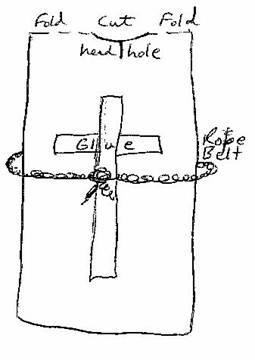 Make Crusader tunics: Take a large men’s white T-shirt or a length of white fabric with a head-hole in the middle. Cut a cross from red fabric and glue with fabric glue to each side of the tunic; or use 2 pieces of red ribbon for the cross. These could be used as nightgowns or at the beach. Budget doesn't run to T-shirts and fabric? Use paper grocery bags!
Make Crusader tunics: Take a large men’s white T-shirt or a length of white fabric with a head-hole in the middle. Cut a cross from red fabric and glue with fabric glue to each side of the tunic; or use 2 pieces of red ribbon for the cross. These could be used as nightgowns or at the beach. Budget doesn't run to T-shirts and fabric? Use paper grocery bags!
- Close with prayer: Lord, may I love your cross more and more each day.
Fall of Constantinople
FALL OF CONSTANTINOPLE
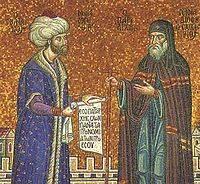
Objectives:
- Students should know that 1000 years after the fall of Rome, Constantinople fell to the Moslems named Turks.
- Students should have some idea why this is important in history.
Possible Lesson Plan:
- Open with prayer.
- Tell the story of the Fall of Constantinople:
In 1451 the Moslem Turks had a new king, Mehmet. Mehmet had only one idea in his mind; he told his generals, “There is only one thing I want: Give me Constantinople!” Mehmet was sure he could conquer the great capital of the Byzantine Empire. So, he gathered a great army to prepare for his attack, and built huge numbers of ships until he had the greatest navy in the East. He also built a great cannon, so big that it had to be drawn by 60 oxen and loaded by 200 men. No city had ever been attacked by a cannon before.
Constantinople, weakened by the Crusaders, had only an army of 8000 soldiers and 30 ships. But, the city was built on a peninsula —— a strip of land surrounded on three sides by the sea. There were huge walls around the whole city; these had held off many Moslem armies over hundreds of years.
Mehmet moved his army into place on the day after Easter in 1453. He asked the Emperor to surrender and give the city to the Moslems; the Emperor would not give up that easily. Soon the huge cannons were pounding the walls, but the walls held. Mehmet’s ships held the waterways and kept food from reaching the city. But, he could not enter the city. Finally, Mehmet built a huge pontoon bridge across the water. Now his armies could attack from both sides. The Christians were hungry and weak. But, they continued to fight.
Finally, the Turks prepared for their last big attack. The Emperor spoke to his people and told them to be ready to die for their Lord and their homes. Then the Christians all took communion in the many churches of the city and went to the walls to be ready for battle. In the middle of the night, Mehmet attacked. The thick walls of the city were no match for the huge cannon. This time his troops rushed up the walls of the city and charged into Constantinople. For three days, the Moslems sacked the city, killing all Christians they could find, stripping all the riches of the homes and churches, and burning whole sections of the wonderful city. The great Church of St. Sophia was renamed a Moslem mosque. The Byzantine Empire, outliving Rome by a thousand years, was finally defeated.
Add the Fall of Constantinople to your timeline.
- True/False Questions:
True False
Mehmet was king of the Turks. Mehmet was Emperor of Constantinople.
Mehmet attacked with a cannon. Mehmet attacked with bows and arrows.
Mehmet conquered Constantinople. Mehmet ran away in fear.
- Discuss for a bit weapons of war. Boys will like this lesson. What weapons can they think of? What were some early weapons? (bows and arrows, spears) Draw them. How might an army attack a city like Constantinople with these weapons? How did a war with these weapons sound? Look? How might the city be defended? How would a city be built so as to be easy to defend? With the invention of gunpowder and cannons (and later, guns), all war was changed. How might an army with cannons attack a city? What about sound and sights now? War has now become noisy! How can the city be defended? Were castles and walls as important as before?
- Make “Headline Stories”: Give students a pile of old newspapers. Have each come up with a good headline for today’s lesson, along the lines of “Walls of Constantinople Today Fall Before Turks”. Cut out letters from headlines in newspaper and glue to a piece of construction paper to make their own headline.
- Close with prayer: Lord, give us the courage of those brave Christians in Constantinople when Mehmet attacked.
Protestant Reformation: Part 1
THE PROTESTANT REFORMATION
Objectives:
- Students should know who Martin Luther was and what he did.
- Students should be able to name some of the Protestant denominations.
Possible Lesson Plan:
- Open with prayer.
- Tell the story of the Protestant Reformation up through Martin Luther.
As the years went by after the fall of Rome in the West, the church there came to be led by only one bishop, the Bishop of Rome, known also as the pope. He began to teach that he was the ruler of all the Christian church and that he alone could tell the true teachings of God. His Churches were led by Roman and were called Roman Catholic. These churches in the West began to teach that a man had to pay for any sins he committed on earth and they sold indulgences to Christians to help them pay for their sins. Soon the church was wealthy, but the people had lost touch with the real Jesus in many ways.
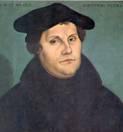 Finally, a monk named Martin Luther stood up against the church officials. He opposed the wealth of the church and the selling of payment for sins. He made a public announcement of his views by nailing a paper with 95 questions on it to the door of the cathedral, or church, of Wittenburg. But, the Pope was not happy with Martin Luther. He issued a decree throwing Luther out of the Church! Martin Luther built a bonfire and burned the decree. Luther had meant only to talk the church into going back to the old teachings of the apostles, but now he had no church at all. The Pope asked King Charles of Spain to talk to Luther. King Charles ordered Luther to come to the city of Worms – funny name for a city, right? When Luther got there, King Charles ordered Martin Luther to stop talking about the things he believed. Martin Luther refused. Some of Charles’s nobles thought Luther should be burned at the stake, Charles let him go and his friends hid him from the angry nobles. So, Luther formed his own church, soon called the Lutheran church. He translated the Bible into German, the language of his people, and soon had many followers who call themselves Lutherans.
Finally, a monk named Martin Luther stood up against the church officials. He opposed the wealth of the church and the selling of payment for sins. He made a public announcement of his views by nailing a paper with 95 questions on it to the door of the cathedral, or church, of Wittenburg. But, the Pope was not happy with Martin Luther. He issued a decree throwing Luther out of the Church! Martin Luther built a bonfire and burned the decree. Luther had meant only to talk the church into going back to the old teachings of the apostles, but now he had no church at all. The Pope asked King Charles of Spain to talk to Luther. King Charles ordered Luther to come to the city of Worms – funny name for a city, right? When Luther got there, King Charles ordered Martin Luther to stop talking about the things he believed. Martin Luther refused. Some of Charles’s nobles thought Luther should be burned at the stake, Charles let him go and his friends hid him from the angry nobles. So, Luther formed his own church, soon called the Lutheran church. He translated the Bible into German, the language of his people, and soon had many followers who call themselves Lutherans.
 In other countries, other men were also protesting the teachings of the Pope. John Calvin in Switzerland formed the Reformed Church. In his church, he began to choose those teachings of the Church Fathers that he would follow and those that he would not. For example, Calvin got rid of all monks, bishops, and priests. Soon his followers, known as Calvinists, had stripped their churches of all pictures, stained glass, candles, and robes; they would not dance or play games or go to the theater. And, even though at first Calvin had been attacked by the Pope, soon the Calvinists were punishing those who disagreed with their beliefs in Switzerland.
In other countries, other men were also protesting the teachings of the Pope. John Calvin in Switzerland formed the Reformed Church. In his church, he began to choose those teachings of the Church Fathers that he would follow and those that he would not. For example, Calvin got rid of all monks, bishops, and priests. Soon his followers, known as Calvinists, had stripped their churches of all pictures, stained glass, candles, and robes; they would not dance or play games or go to the theater. And, even though at first Calvin had been attacked by the Pope, soon the Calvinists were punishing those who disagreed with their beliefs in Switzerland.
 In the land of England, the church of Rome was also losing power; but for a different reason. King Henry the Eighth wanted to get rid of his wife and marry his new girlfriend and the Pope wouldn’t let him. So, Henry declared himself head of the new Church of England and took from the bishops and monks all the lands and churches of the Pope. When people from the Church of England came to the new land of America, they became known as the Protestant Episcopal Church of America.
In the land of England, the church of Rome was also losing power; but for a different reason. King Henry the Eighth wanted to get rid of his wife and marry his new girlfriend and the Pope wouldn’t let him. So, Henry declared himself head of the new Church of England and took from the bishops and monks all the lands and churches of the Pope. When people from the Church of England came to the new land of America, they became known as the Protestant Episcopal Church of America.
Soon there were many new teachers, each forming his own church with his own choice of teachings. A teacher named John Wesley pursued a way of life of Bible study and prayer; his followers became known as Methodists. John Calvin taught that people are chosen before birth to be Christians and believed that each church should vote on what to believe and who to follow; his followers are called Presbyterians. Another group of Christians under John Smyth believed that people should only be baptized when they are grown up; these were called Baptists. Another believed that Christians should worship on Saturday, the seventh day of creation; these were called Seventh Day Adventists and were led by William Miller of New York. By now there are hundreds of groups of Christians, called denominations, in the West, each with its own set of customs and beliefs. While all these groups believe in Jesus Christ, each has chosen only parts of the teachings of the early Church and left other traditions behind.
Add Martin Luther to your timeline.
- True/False Questions:
True False
The pope is the head of the Roman Catholic The lion is the head of the Roman Catholic
Church. Church.
Martin Luther nailed his paper to the Martin Luther mailed his paper to the king.
Cathedral door.
King Charles ordered Luther to come to King Charles ordered Luther to come to
the city of Worms. Constantinople.
Martin Luther translated the Bible into Cyril and Methodius translated the Bible
German. into German.
- Try singing 3 verses of the “Ants Go Marching”:
The Church goes marching one by one…the Orthodox Church is the only one
And they all go marching down, to the church, to worship the Lord.
The Churches go marching 2 by 2…the Roman Pope makes the church two,
And Roman Catholics go marching down…
The Churches go marching 3 by 3…Martin Luther nails up his scroll…and the
Lutherans go marching down…
5. Make a Martin Luther “foursquare” finger game: Copy the pattern on the next page. Cut it out as a square. Fold it as you do a foursquare game (ask your children, they know how) and play questions and answers!
6. Close with prayer: Lord make Your Church one again as we once were one.
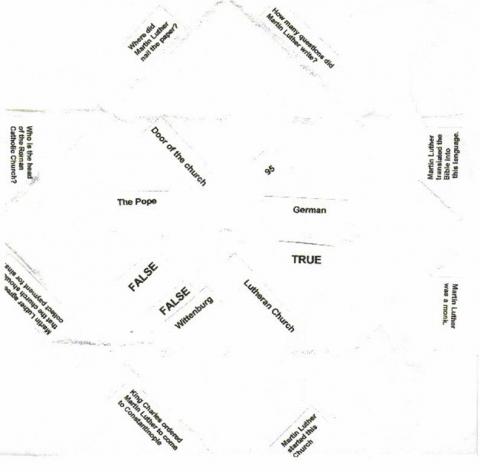
Protestant Reformation: Part 2
PROTESTANT REFORMATION, PART 2
Objectives:
- Children should know the name of Henry the Eighth of England and that he started the Church of England.
- Children should know that, sadly, the church is divided into many little churches today, some of their names and beliefs.
Possible Lesson Plan:
- Open with prayer.
2. Read the second half of the story of the Reformation above.
Add King Henry VIII to your timeline.
- True/False Questions:
True False
Henry VIII was King of England. Henry was King of Jerusalem.
Henry started his own church so he Henry started his own church because
could get rid of his wife. he loved the Lord so much.
Baptists believe you must be all grown Baptists worship John the Baptist.
up to be baptized.
- Finish your little learning song; it’s really better if the students make up the lines (They’ll remember them better!), but if no ideas are forthcoming…
The Churches go marching 4 by 4…Calvin gets rid of all the priests…
Presbyterians go marching down…
The Churches go marching 5 by 5...King Henry gets rid of his Spanish wife…
Episcopalians go marching down…
The Churches go marching 6 by 6…John Wesley studies his Bible more…
Methodists go marching down…
The Churches go marching 7 by 7…Grown-ups only can be baptized…
And the Baptists go marching down…
The Churches go marching 8 by 8…Saturday is the most holy day…
Seventh Day Adventists go marching down…
- Talk a bit about the unity of the Church. Jesus prayed a whole chapter for His Church to be one. When did He pray this? (on Holy Thursday at the Last Supper) For 1000 years, there was only one Christian Church. But, in the West, as time went on, people couldn’t agree on exactly what to believe and how to worship. How did the Church in the first 1000 years settle any disagreements? They called a Church Council and made a decision all together. Now, without the councils, there is no one to decide. So, each teacher just makes his own church. How would Jesus feel when He sees His Church all divided up now? Do we feel sad, too? Jesus calls His Church His body. How would you feel if someone cut off a finger or a toe? Does it hurt to break the body of Jesus? Do you know anyone who goes to a Christian Church that is not Orthodox? A Roman Catholic? A Baptist? A Methodist? Do they love Jesus, too? Do you love them just as Jesus loves them?
6. Make a “Broken Body of Jesus Puzzle”: Take the icon of Jesus. Color and glue in the center of a piece of construction paper. Now, carefully cut out the icon part, leaving the border intact. Turn over. Draw 7 puzzle pieces on the back. Label each: Roman Catholic, Lutheran, Church of England, Baptist, Methodist, Seventh Day Adventist, Presbyterian. Cut apart carefully. Can you put Jesus broken body back together again?
7. Close with prayer: Lord, make your Church one, just like You are One.
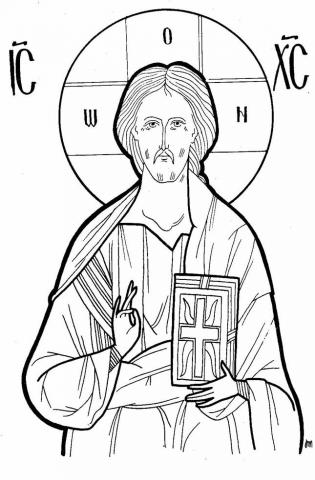
ST
St. Gregory, Enlightener of Armenia
ST. GREGORY, ENLIGHTENER OF ARMENIA
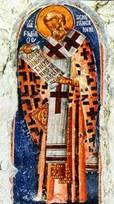
Objectives:
- Students should know the name of Gregory and be able to tell his story.
- Students should know the name of Tirdat, King of Armenia.
Possible Lesson Plan:
- Open with prayer.
- Tell the story of Gregory, Enlightener of Armenia.
For many years, Tirdat, young King of Armenia, lived in Rome. His father, the King of Armenia, had been killed by an angry murderer. Finally, King Tirdat was coming home to his land of Armenia. On the way, he met a young man named Gregory. Young King Tirdat liked Gregory and invited him to come to Armenia with him and be in his court. Gregory went with Tirdat. Neither Gregory nor Tirdat knew a terrible secret: Gregory was the son of the murderer!
Soon they were home to Armenia. What a celebration! The Armenian people cheered for their young king as he rode through the streets. Tirdat went right away to the statue of the goddess Anahid, goddess of the earth. He put a wreath in front of the statue and worshipped the statue. All the other people did the same – all but Gregory. Gregory was a Christian. He told King Tirdat that he worshipped only Jesus, the Son of God.
King Tirdat was very angry. How dare Gregory disobey him, the king? He even found out that Gregory was the son of his father’s murderer. He ordered Gregory thrown into prison. There Gregory stayed for 15 years in a dark pit. Have you been alive even that long? An old woman secretly brought the Christian prisoner food. After many years, King Tirdat became ill. His sister loved her brother and had dreams about the young man in prison. Maybe Gregory could help her brother, the king. She made up her mind to send for Gregory to be brought to the palace. There Gregory prayed for King Tirdat and he was healed.
Now that Gregory was out of prison, he began to tell the Armenian people about Jesus. He wanted to build churches for them to worship the Lord. One day he saw a vision of a column of fire with a cross on top. Here he would build his church – the first in all Armenia. Soon there were churches all over the country. Gregory went everywhere, telling people about the Christian faith, building churches, and helping the poor.
King Tirdat and all his family gathered by the river. One by one they were baptized by Gregory, now a bishop, and had communion for the first time. Armenia was now a Christian country. And the king who had thrown Gregory into prison became his greatest helper and friend. We call Gregory “Enlightener” because he brought God’s light to the Armenian people.
Add St. Gregory to your timeline.
- True/False Questions:
True False
King Tirdat was from Armenia. King Tirdat was king of Rome.
King Tirdat gave a wreath to the goddess. Gregory worshipped the goddess.
Gregory saw a vision of fire and a cross. Gregory saw a vision of a lion.
Gregory is called the Enlightener. Gregory is called the Endarkener.
- Sing “This little light of mine; I’m gonna let it shine.”
“Gregory worshipped the goddess, NO! I’m gonna let it shine…”
“Tirdat threw him into jail, I’m gonna let it shine…”
Gregory prayed, the king was healed, I’m gonna let it shine…”
Fiery cross a church to build, I’m gonna let it shine…”
Enlightened all of Armenia, I’m gonna let it shine…”
This little light of mine…”
- Have the teacher light a candle. Turn out the lights. What can you see? How bright is the candle? Does it give light to the room? Armenia was dark without God. But Gregory showed them the light of Jesus and then they could see.
- Make Glove Puppets: This story has 5 major “characters”: King Tirdat, Gregory, the old woman, Tirdat’s sister, and the statue of the goddess Anahid. Take a cloth glove; stuff a cotton ball into each fingertip and tie off with a piece of yarn. Draw on faces. Decorate with yarn hair, gold pipe-cleaner crown, fabric or felt headscarves. If you want, a rectangle of felt below the head will resemble clothing. On the palm of the glove, glue a felt cross and red, orange, and yellow felt flames (or use glitter glue for flames). Can you tell the whole story now with your glove to illustrate?
- Close with prayer: Lord, help me to trust You even when things get bad, as did Gregory in the pit.

St. Mark of Alexandria
ST. MARK OF ALEXANDRIA
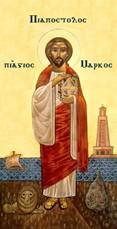 Objectives:
Objectives:
- Students should be able to identify Mark as the writer of the Gospel of Mark, written with St. Peter.
- Students should know that Mark went with Paul and Barnabas on their first journey, but went home partway through.
- Students should identify St. Mark as the first bishop of Alexandria in Egypt.
Possible Lesson Plan:
- Open with prayer.
- Tell the story of St Mark; have ready the pictures of Holy Thursday and of Paul’s first missionary journey from their Bible storybooks:
St. Mark, author of the Gospel that bears his name, is met in the Scriptures with his Jewish name of John, meaning “Yahweh has shown grace”. “Marcus”, while a common Roman name, is an unusual name to find in a Jewish household; it is unclear where this name came from. In many early writings, John Mark bears the nickname, “stumpy-fingered”, possibly due to a physical peculiarity.
John Mark’s mother, Mary, was related to Barnabas, the wealthy landowner of Cyprus, who later became an apostle. Mary, a widow, was a woman of wealth and position in Jerusalem and a follower of Jesus. We meet John Mark in the Garden of Gethsemane as the young man wearing only a linen cloth who, when he was grabbed by the men arresting Jesus, fled naked.
John Mark’s home was a meeting place of the early Christians. In fact, when St. Peter was released from prison in Acts 12, he knows exactly where to go to find the Church. He is met there by the maidservant of the house and left standing on the doorstep until she tells the Christians inside, who joyfully let Peter in.
John Mark remained at home in Jerusalem until he was brought to Antioch by Barnabas and Paul. He traveled with the two to Cyprus on their first missionary journey. But, when the group reached Perga in Asia Minor, John Mark left them and returned to Jerusalem. Paul viewed this as desertion and refused to take John Mark with them on the second missionary journey. Barnabas separated from Paul and took John Mark with him to Cyprus and Paul traveled with Silas. Later, we find John Mark with Paul the prisoner in Rome, past history apparently forgiven. Paul sends Mark on several missions, first to Colossae and later, with Timothy to Asia Minor.
Mark was also a companion and helper of the Apostle Peter in his journeys. While Mark was with Peter in Rome, the faithful asked him to write down for them the life and miracles of the Lord Jesus and Mark wrote carefully that which Peter had witnessed. Peter chose Mark to preach the Gospel in Egypt, and Mark became the first bishop of Egypt. He taught in Pentapolis and then in Alexandria, where he founded a goodly church with priests and deacons. Mark’s teaching in Egypt was confirmed with many miracles. Finally, the pagans brought accusations against Mark and he had to flee back to Pentapolis. He spent two years in Pentapolis, where he continued his earlier work. After two years, Mark returned to Alexandria, to the great joy of the church there, which was growing mightily. But the pagans seized Mark and dragged him over the cobblestones to prison. An angel appeared to Mark in prison and then Jesus Himself appeared and said, “Peace to thee, Mark My Evangelist!” On the next day, the pagans dragged Mark through the streets until, bloody and injured, Mark went home to his Lord. His relics were buried by the Christians and have throughout the ages brought healing to many believers.
Add St Mark to your timeline. Remember that Mark traveled with St. Paul, so he's MUCH earlier on the timeline.
3. True/False Questions:
True False
Mark grew up in Jerusalem. Mark grew up in Egypt.
Mark was at the Garden of Gethsemane. Mark stayed with Jesus at the cross.
Mark wrote down a gospel with the Mark wrote in his gospel what he saw.
memories of Peter.
Mark was first bishop in Alexandria. Mark was first bishop in Rome.
- Mark was all over! Review the stories of the major players in his life – Jesus at the Garden of Gethsemane, Peter being freed from prison, Paul and his first journey with Barnabas, Peter in Rome. But, finally, Mark was all grown up and was sent all by himself to teach the people of Egypt about Jesus. Review the stories of Egypt, especially Joseph and Moses. Egypt has figured heavily in history. Joseph and Mary even took the baby Jesus there to keep him safe from King Herod. Pictures of all of these events are in the students’ Bible storybooks. Look at pictures of Egypt – the pyramids, the Sphinx were all there when Mark was alive and are still there today! Mark ended his life as a martyr; do the students remember the meaning of “martyr”? Can they name some other martyrs? Who was the first martyr?
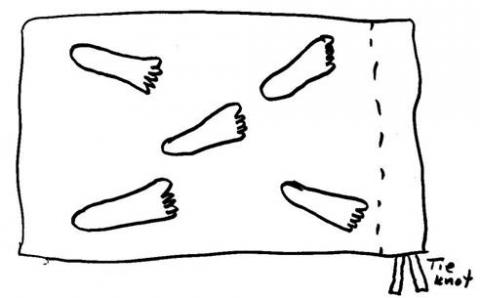 Make Mark’s traveling bag: Mark would definitely need a traveling bag; he went everywhere. Trace his journeys on a map if you want. What would he pack? Take a pillowcase. Cut a small section of the hem at the open end and insert a piece of clothesline or similar rope. Thread it through to close the bag and carry it. On one side, write with permanent marker, St. Mark’s Traveling Bag. Put on a smock (available in classroom) Now take off your shoes! Have each student dip his foot in paint (not too much!) and make footprints on the other side of the bag. Use acrylic paint so it will be permanent. Let dry till next week and take home.
Make Mark’s traveling bag: Mark would definitely need a traveling bag; he went everywhere. Trace his journeys on a map if you want. What would he pack? Take a pillowcase. Cut a small section of the hem at the open end and insert a piece of clothesline or similar rope. Thread it through to close the bag and carry it. On one side, write with permanent marker, St. Mark’s Traveling Bag. Put on a smock (available in classroom) Now take off your shoes! Have each student dip his foot in paint (not too much!) and make footprints on the other side of the bag. Use acrylic paint so it will be permanent. Let dry till next week and take home.
- Close with prayer: Lord, make Me your obedient and good traveler, going wherever You need me as did St. Mark.
Greece: Archbishop Athenagoras
ARCHBISHOP ATHENAGORAS
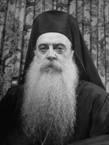
Objectives:
- Students should be able to say his name and tell his story.
- Students should know that he was the first Greek bishop of the church in America.
Possible Lesson Plan:
- Open with prayer.
2. Tell the story of Archbishop Athenagoras of Greece and America:
For centuries the Greeks had been ruled by the Turks. Do you remember the Moslem Turks from our lessons on the Crusades and on the Fall of Constantinople? Finally, almost 200 years ago, just after our country got its independence, the Greeks threw the Turks out of their country and were free to worship Jesus again.
Soon, Greek people were coming to our country – cotton merchants in the South, sponge divers in Florida – all wanted to have Orthodox Christian churches to worship in. They built churches and priests came from Greece. But, there was no bishop – no shepherd to lead the Greek people in America. Each church in each town just did what its priest thought was right. People argued; no one decided. Finally, Archbishop Athenagoras was elected by the bishops of Greece to be the first bishop of the Greek Church in America. He was a tall man with a long, flowing beard. He brought the churches together, built schools, started new churches. The Greek people in America had a leader for their flock. Do you remember what a bishop is? Bishop Athenagoras loved his people as a shepherd and cared for them until he died about 50 years ago.
Add Archbishop Athenagoras to your timeline.
3. True/False Questions:
True False
Greece used to be ruled by the Turks. Greece used to be ruled by pharaohs.
Greek Christians came to America. Greek Christians hated America.
Athenagoras was the first Greek bishop of Athenagoras was the first bishop of
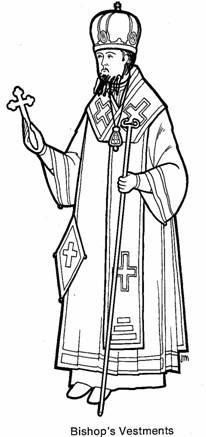 America. Greece.
America. Greece.
4. Review the role of a bishop: What was the role of the original deacons? How were new churches born in the New Testament days? How many churches were there in a city at first? The head of the city’s church was who? How did the need for more than one priest in a city develop?
Who is the head of the bishop? (Christ Himself) What is the primary function of the bishop? (to perpetuate the church) What does a bishop oversee? (diocese) Who has the ultimate authority within a diocese? (the bishop) Who can ordain and through whose authority? Why can’t just anyone ordain a man if everyone can see he has the “gift”? What does “episkopos” mean? (overseer) Can a bishop be married? Show the picture of a bishop in his vestments. Have any of you seen a bishop?
What is the relationship between bishop, priest, and deacon? What sacraments does a bishop share with a priest and a deacon? How has the role of deacon changed through the centuries? What does the word “presbyter” mean? (representative) What does the word diakonos mean? (server or assistant)
5. Look at some pictures of Greece. What are its buildings like? The weather? The houses, people, clothing, customs? How are these like us and how different? What about food? Has anyone eaten Greek food? Can you remember some of the dishes? We will be making Greek sweet biscuits called Koulourakia in class. Do you like Greek food?
- Make Koulourakia: Make dough ahead of time and bring to class.
4 eggs: beat whites till stiff, then beat in yolks, one at a time.
2 cups sugar, 1/3 cup OJ, 2 tsp vanilla, ½ cup melted butter: beat all in in that order.
6-7 cups flour with 3 tsp baking powder: Add slowly until batter becomes a soft ball.
Knead till elastic. Then let students shape their sweet biscuits with a walnut-size piece rolled into a long snake, brush with beaten egg, and bake on greased cookie sheet 350 degrees for 15-18 minutes. Enjoy!
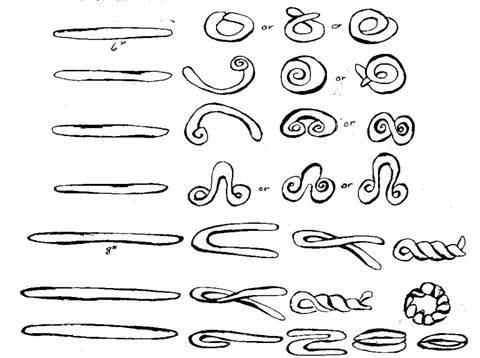
- Close with prayer: Lord, we thank you for Your bishops who care for Your churches all around the world and pray for them every day.
Bulgaria: St. Zlata
ST. ZLATA OF BULGARIA
Objectives:
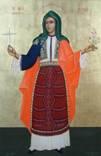 Children should be able to tell the story of St. Zlata..
Children should be able to tell the story of St. Zlata..
Possible Lesson Plan:
- Open with prayer.
- Tell the story of St. Zlata:
Zlata lived in the village of Slatina in the country of Bulgaria. She was very poor, but loved Jesus with her whole heart. She was also beautiful and kind. All the village loved Zlata.
In those days, the Moslem Turks ruled Bulgaria. They hated all Christians. Remember the Romans? One day, a Turk saw Zlata as she was gathering firewood for her family. He decided he wanted her for his wife and captured her. He took her to his home. There he decided she must first become a Moslem before he could marry her. But Zlata would not deny Jesus Christ her Lord.
The Turk promised Zlata riches and slaves to do her work for her. But, she would not deny Christ. She told him that she was waiting for the mansion in heaven Jesus promised. Then the Turk threatened her with terrible tortures, but she told him she was not afraid to suffer for Jesus. Then he had her live for six months with his Turkish women; they tried to trick her into denying Jesus and even tried magic. But nothing would get Zlata to deny Jesus. The Turk then went to her family and told them they would all be killed if she did not become a Moslem. They tried to get Zlata to at least pretend to be a Moslem, but she told them that she would not lie to God.
The evil Turk was beaten. He tortured Zlata, but all she did was pray. The Turk was furious. He hung her in a tree and cut her into pieces. So St. Zlata became a martyr and went home to heaven with her beloved Jesus.
Add St. Zlata to your timeline.
- True/False Questions:
True False
Zlata was from Bulgaria. Zlata was from Constantinople.
Zlata was captured by the Turks. Zlata was captured by the Egyptians.
Zlata would not deny Jesus. Zlata pretended to be a Moslem.
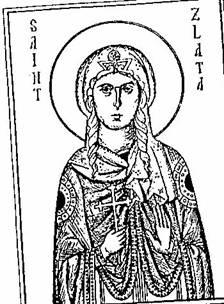 Review the definition of “martyr”. What other martyrs can the students name? We often think of martyrs as living (and dying) in the first couple of centuries of Christianity, but Zlata only about 200 years ago. Are there countries today where people are tortured and killed for being a Christian? We are free to worship the Lord in this country. How thankful we should be for this privilege. What would you do if it were illegal to go to Church? Would you be willing to be thrown in prison?
Review the definition of “martyr”. What other martyrs can the students name? We often think of martyrs as living (and dying) in the first couple of centuries of Christianity, but Zlata only about 200 years ago. Are there countries today where people are tortured and killed for being a Christian? We are free to worship the Lord in this country. How thankful we should be for this privilege. What would you do if it were illegal to go to Church? Would you be willing to be thrown in prison?
- Make St. Zlata’s tree: Take a piece of wax paper. Cut leaves of several shades of green tissue paper (or press some real leaves from outdoors) and a trunk from brown tissue paper. Cut out St. Zlata and color her. Arrange the icon and the trunk and scattered leaves on the wax paper. Cover with another piece of wax paper and iron with a low iron setting. Be sure there is some space around the edges and between some of the leaves (there can be some overlap).
OK, no iron? Use clear self-adhesive laminating sheets instead.
Close with prayer: Lord, give me as much love for You as had St. Zlata.
St. Nicholas of Japan
ST. NICHOLAS OF JAPAN
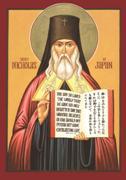
Objectives:
- Students should be able to name Nicholas as the evangelizer of Japan.
- Students should know a bit about the Japanese culture and language.
Possible Lesson Plan:
- Open with prayer.
- Tell the story of St. Nicholas of Japan:
John Kasatkin was born almost 200 years ago in the land of Russia. John’s mother died when he was only five years old. John and his father were very poor, but John was smart and studied hard in school. In school, John heard about many lands far away – China and Japan. He wanted to tell the people of these lands about Jesus.
Then one day a note was put up on the bulletin at John’s school. The Russians in Japan were asking for a priest. John had finished his studies to be a priest. He first became a monk, and was given the name, Nicholas. Then he was ordained a priest. He was ready to go to Japan.
But, the samurai who ruled Japan hated all foreigners! They had their Shinto religion and did not want anyone talking about Jesus. Nicholas spent several years waiting, but while he waited he learned the language and customs of the Japanese people. A few came to him in secret and learned about the Christian faith. Many of these early believers were thrown in prison, just as the Romans had the earlier Christians. But, Nicholas never gave up.
Finally, the rulers allowed the Christian faith. Nicholas could print Bibles in the Japanese language and open churches and teach priests. Foreigners were still not allowed in most parts of Japan, but these new Japanese priests could tell the people all over the country about Jesus. Soon there were hundreds of Christians all over Japan. Nicholas opened schools, both for boys and girls. This was new for the Japanese; girls usually did not go to school.
Nicholas became the first bishop of Japan. He built the beautiful Holy Resurrection Cathedral in Tokyo. He traveled all over Japan visiting Churches. He loved the Japanese people, so much so, that he stayed in Japan during the Russian-Japanese war, even though many of the Japanese rulers thought he was a spy! Nicholas died at the age of 76 in his beloved Japan and is called “Equal to the Apostles”.
Add St. Nicholas of Japan to your timeline.
- True/False Questions:
True False
Nicholas was born in Russia. Nicholas was born in Japan.
Nicholas learned the Japanese language. The Japanese learned the Russian language.
Nicholas is called “Equal to the Apostles”. Nicholas was a Russian spy.
- Talk a bit about Japanese culture: This time, act it out. Have the children take off their shoes and line them up at the door. Bring some small blankets they can lie down on and roll up along the walls of the classroom. Teach a few words of Japanese, bowing a bit when saying “Ko-nee-chee-wah”, or “Hello”. Have a cup of tea, sitting on the floor, bowing to each other. Talk about the importance of learning other people’s ways, which shows you respect their customs. This is what Nicholas did in Japan; he learned the Japanese language, good Japanese manners, ate Japanese food, and lived in a Japanese home. He was loved for this by the Japanese people.
- Make a Japanese pearl necklace: Japan is known for its pearl divers. Do you know where pearls come from? Use a piece of fishing line for the necklace. Buy a bag of mixed size fake pearls. There is no need to put enough pearls on the line to go all the way around the neck. Use 10-12 pearls per student and make a beautiful necklace arranging them by size. In the end, tie the ends to fit exactly around the neck but able to get over the head; alternatively, you can purchase necklace fasteners and tie one on each end. The knots must be cemented with household cement or something similar; fishing line will otherwise untie itself! The boys can make these for their mothers.
- Close with prayer: Lord, help me to love other people enough to learn what they like and do things their way.
St. Innocent, Apostle to America
ST. INNOCENT, APOSTLE TO THE AMERICAS
Objectives:
- Students should identify St. Innocent as Apostle to the Americas.
- Students should know that he traveled and evangelized in Alaska.
- Students should know that he was from Russia.
Possible Lesson Plan:
- Open with prayer.
- Tell the story of St. Innocent:
About 200 years ago there was born in Russia a man named John Veniaminov. John, like many young men, got married and decided to become a priest. He had a baby boy. Life was fairly normal – but not for long.
One day Bishop Michael of Irkutsk asked for a priest to volunteer to go to far-away Alaska in the wilderness. There was a need for priests and teachers among the Eskimos and Aleuts. John volunteered; the bishop was so happy he called John the “son of obedience”. Soon John with his wife and little baby boy were on their way. Their ship landed in Unalaska, a damp, cold, windy, treeless place where lived Eskimos called Aleuts. John made friends with the Aleuts, learning their language. He also rebuilt their church, hammering and sawing himself till it was done. The Aleuts were so happy; they loved their new priest. John and his wife also cared for the poor and sick and built a school and orphanage for children.
John wanted to tell all the Aleuts about Jesus. So, he traveled to all the surrounding islands by kayak. The water was cold and full of icebergs. But John spent days traveling by kayak and dogsled, telling people about the Lord and building churches. His legs became bent into the shape of a kayak, but still he traveled. Then, John and his family were sent to another tribe called the Kolosh in Sitka, Alaska. There he learned another language and was able to tell his new friends about Jesus. Slowly the Kolosh also became Christian.
Later, John was called to Russia. He was ordained a bishop and took the new name Innocent. He went back to Alaska as bishop. His territory included all his old friends, the Aleuts and the Kolosh. Bishop Innocent traveled by dogsled and kayak all over his diocese. He would spend the night cooking on a fire and roll up in his blanket with his Eskimo friends to sleep. Bishop Innocent was a true missionary and is remembered as the evangelizer of the Aleuts and the apostle to America.
Add St. Innocent (with St. Herman) to your timeline.
- True/False Questions:
True False
St. Innocent’s birth name was John. St. Innocent’s birth name was Michael.
St. Innocent traveled to Alaska. St. Innocent traveled to Rome.
St. Innocent traveled by kayak and dogsled. St. Innocent traveled by plane and train.
St. Innocent was the first bishop of Alaska. St. Innocent was bishop of Constantinople.
- We have now studied many men who were successful “missionaries”; what is a missionary? What makes a missionary successful? What were some of the things St. Innocent did that made the people of Alaska love him and love the Jesus they saw in him? Brainstorm a bit – learning their language, traveling in their way, not afraid of hard work building churches, etc. What about Nicholas in Japan? If you became a missionary, what could you learn from these wonderful saints about how to tell people about Jesus? Are there missionaries today? Are there people today who still don’t know about Jesus? Are we reaching out to them? Mention IOCC and OCMC – Orthodox missionary organizations that teach, give food to the poor, etc. Is there anything your class wants to do to help the people of other lands?
- Make Bishop Innocent’s dogsled: Shape the sled with popsicle sticks. Place inside a figure of Innocent made with a pipe cleaner or an icon picture mounted on a pipe cleaner. Make dogs from pipe cleaners and attach with yarn harnesses.
- Close with prayer: Lord, help me to care for Your children in other countries and tell them about Your love for them, too.
